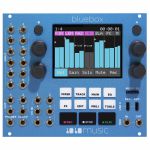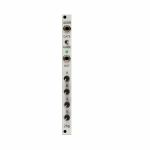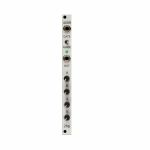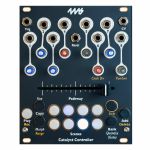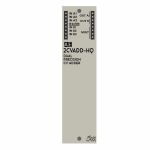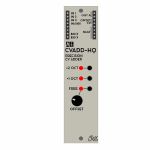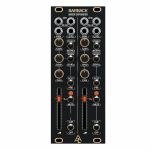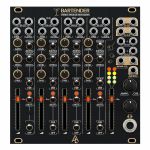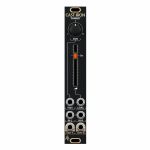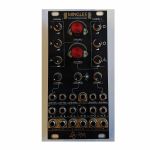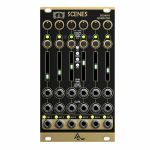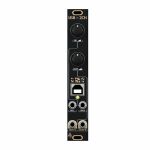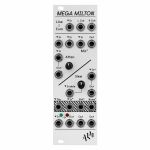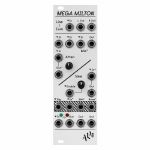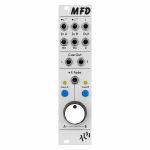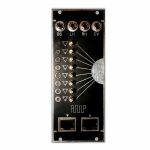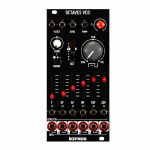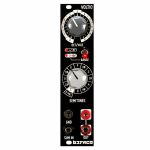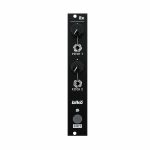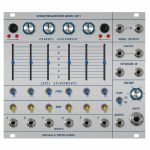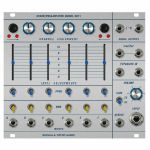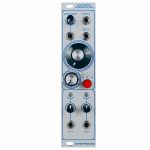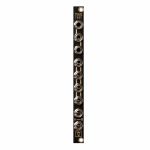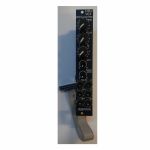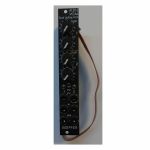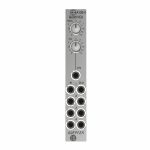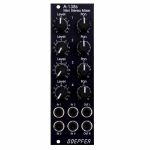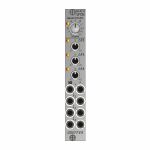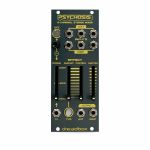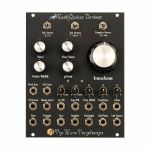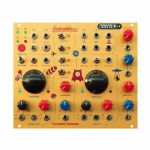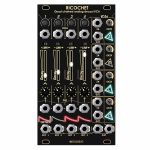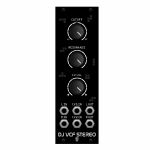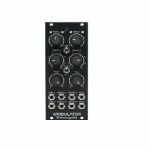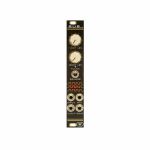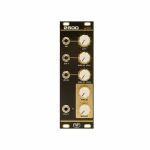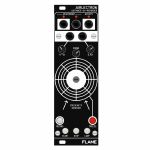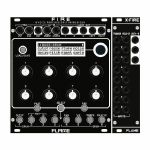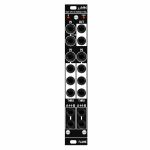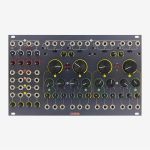100% Sicheres Einkaufen
Studio equipment
Our full range of studio equipment from all the leading equipment and software brands. Guaranteed fast delivery and low prices.
100% Sicheres Einkaufen
DJ equipment
Our full range of DJ equipment from all the leading equipment and software brands. Guaranteed fast delivery and low prices. Visit Juno DJ
Filter
Synth modules
The Eurorack modular synth format is one of the most exciting areas of music technology. Pioneered by Doepfer, there are now hundreds of brands offering compatible modules of all varieties. You can combine your choice of the best oscillators, filters and much more in order to create a unique, bespoke synth setup which perfectly suits your needs.
Eurorack modules offer the biggest range of options you can imagine, from basic analogue modules which replicate the sound of classic vintage synths, through to digital modules which allow you to explore completely new approaches to making music.
Whether you’re a beginner or a more experienced modular head, you can take your pick of the best modules from leading brands including Mutable Instruments and ALM Busy Circuits.
Our range also includes accessories, cases, patch cables and much more, allowing you to build and customise your perfect modular synth setup.

1010 Music Bluebox Digital Mixer & Recorder Module With Effects (mixer synth module)
Cat: 970244 Rel: 23 Oct 23
Mixer module with effects and multi-channel recording/playback - 30HP.
Notes: Eurorack version of 1010's superb Bluebox. Vast power in 30 HP, with the ability to mix, record and play back in mono and stereo, hook up to a computer over USB for stereo I/O and run effects, all with CV control.
Supplier's Notes:
The bluebox Eurorack edition is the new Eurorack mixer with effects and multichannel recording/playback based on the award-winning bluebox desktop mixer. With the Eurorack edition's USB-C EXT port, you can send 2 channels of audio to and from your computer. Plus, you can control up to 6 mix settings with the 6 CV inputs. Whether recording your Eurorack jams, using it to play stems as backing tracks, or a combination of both - bluebox Eurorack edition will rock your rack!
Connect your eurorack, sampler, drum machine, and synthesizer outputs to 12 mono, 3.5 mm inputs and map them to 12 mono tracks or 6 stereo tracks - all with independent control for recording and playback. Connect your computer to the USB C port to send and receive two channels of audio.
The bluebox Eurorack edition is the ultimate in compact mixing, effects, recording, and playback for Eurorack. Smack it in your rack and hit the road with a self-contained, electronic music powerhouse!
When you purchase a bluebox Eurorack edition, you will receive:
a bluebox Eurorack edition 30 HP Eurorack module
A microSD card with bluebox firmware and pre-loaded project files
two Eurorack power cables
a bluebox Eurorack edition Quick Start guide
two MIDI Adapters
Technical Specs
Dimensions & Power
30 HP
Module dimensions including knobs: 6" x 5"x 1.6"
Depth behind front panel with ribbon cable: 1.0"
Requires the +5V rail which may not be present
on some older racks.
Uses 500-850mA at +5V (depending
on screen brightness), 320 mA at +12V, and 82mA at -12V
Requires two power connections
Capabilities
12 mono tracks, 6 stereo tracks or something in between
Connect to TRS or USB C MIDI for beat syncing effects
Lots of headroom with support for Eurorack levels up to +/-5V inputs and outputs
3 effects: reverb, delay and compressor
Records and plays back 48k, 24-bit audio WAV files
4 band EQ per track
Durable aluminum faceplate
Stream 2 channels of audio in and out over USB C
Inputs and Outputs
12 mono 3.5 mm TS inputs
2 independently controlled 3.5 mm TS output pairs that can be used as 4 mono outputs
1 stereo 3.5 mm headphone output
6 CV Inputs
1 USB C MIDI Device port
1 TRS MIDI Input
1 TRS MIDI Output
1 USB C Ext jack for streaming audio
3.5" touch screen, 4 knobs, 8 navigation buttons and 3 transport buttons
… Read moreSupplier's Notes:
The bluebox Eurorack edition is the new Eurorack mixer with effects and multichannel recording/playback based on the award-winning bluebox desktop mixer. With the Eurorack edition's USB-C EXT port, you can send 2 channels of audio to and from your computer. Plus, you can control up to 6 mix settings with the 6 CV inputs. Whether recording your Eurorack jams, using it to play stems as backing tracks, or a combination of both - bluebox Eurorack edition will rock your rack!
Connect your eurorack, sampler, drum machine, and synthesizer outputs to 12 mono, 3.5 mm inputs and map them to 12 mono tracks or 6 stereo tracks - all with independent control for recording and playback. Connect your computer to the USB C port to send and receive two channels of audio.
The bluebox Eurorack edition is the ultimate in compact mixing, effects, recording, and playback for Eurorack. Smack it in your rack and hit the road with a self-contained, electronic music powerhouse!
When you purchase a bluebox Eurorack edition, you will receive:
a bluebox Eurorack edition 30 HP Eurorack module
A microSD card with bluebox firmware and pre-loaded project files
two Eurorack power cables
a bluebox Eurorack edition Quick Start guide
two MIDI Adapters
Technical Specs
Dimensions & Power
30 HP
Module dimensions including knobs: 6" x 5"x 1.6"
Depth behind front panel with ribbon cable: 1.0"
Requires the +5V rail which may not be present
on some older racks.
Uses 500-850mA at +5V (depending
on screen brightness), 320 mA at +12V, and 82mA at -12V
Requires two power connections
Capabilities
12 mono tracks, 6 stereo tracks or something in between
Connect to TRS or USB C MIDI for beat syncing effects
Lots of headroom with support for Eurorack levels up to +/-5V inputs and outputs
3 effects: reverb, delay and compressor
Records and plays back 48k, 24-bit audio WAV files
4 band EQ per track
Durable aluminum faceplate
Stream 2 channels of audio in and out over USB C
Inputs and Outputs
12 mono 3.5 mm TS inputs
2 independently controlled 3.5 mm TS output pairs that can be used as 4 mono outputs
1 stereo 3.5 mm headphone output
6 CV Inputs
1 USB C MIDI Device port
1 TRS MIDI Input
1 TRS MIDI Output
1 USB C Ext jack for streaming audio
3.5" touch screen, 4 knobs, 8 navigation buttons and 3 transport buttons
2 in stock $675.74
Click for better price!
or call +44 20 7424 1960
quote 970244
quote 970244
2hp ADSR 4-Stage Linear Envelope Module (silver) (B-STOCK) (envelope generator synth module)
Cat: 982540 Rel: 01 Jan 90
B-STOCK: Box opened, product in perfect working order
Notes: ***B-STOCK: Box opened, product in perfect working order***
ADSR is a four stage linear envelope with two expressive ranges. Each stage can be modified independently allowing for the creation of complex, multi-segment envelopes. Great for modulating filters, VCAs, and oscillators.
… Read moreADSR is a four stage linear envelope with two expressive ranges. Each stage can be modified independently allowing for the creation of complex, multi-segment envelopes. Great for modulating filters, VCAs, and oscillators.
1 in stock $85.51
2hp ADSR 4-Stage Linear Envelope Module (silver) (B-STOCK) (envelope generator synth module)
Cat: 985275 Rel: 01 Jan 90
B-STOCK: Without original box, product has light surface marks but otherwise in perfect working condition.
Notes: ***B-STOCK: Without original box, product has light surface marks but otherwise in perfect working condition.***
ADSR is a four stage linear envelope with two expressive ranges. Each stage can be modified independently allowing for the creation of complex, multi-segment envelopes. Great for modulating filters, VCAs, and oscillators.
… Read moreADSR is a four stage linear envelope with two expressive ranges. Each stage can be modified independently allowing for the creation of complex, multi-segment envelopes. Great for modulating filters, VCAs, and oscillators.
1 in stock $80.30
4ms Catalyst Controller 8-Channel Macro Controller Module (controller/function generator/sequencer module)
Cat: 995953 Rel: 11 Mar 24
8-channel macro controller module - 20HP
Notes: Really smart integration of macro controls for Eurorack, based on the original design by Emblematic Systems. Assign settings to eight CV outputs then morph with the crossfader or record movements to manage presets or set up complex real-time modulation. Can also operate as Catalyst Sequencer.
Supplier's Notes:
The Catalyst Controller is a macro controller with eight precision CV outputs and a responsive crossfader to morph between scenes. A scene is a snapshot of up to eight CV outputs, like a modular preset. Traverse a "pathway" composed of multiple scenes using the crossfader or an external CV signal, or immediately jump using the scene buttons. Record CV and slider movements, and play recordings back via a button or external trigger.
Each output has sub-millivolt precision and a maximum range of -5V to +10V. Channels have an adjustable morphing curve, can be quantized to common scales, restricted to a particular voltage range, or set to output gates.
Whether used as a CV preset manager, seamless transition generator, chord sequencer, CV recorder, or experimental CV playground, the Catalyst Controller puts control of your modular at your fingertips.
The Catalyst Controller can also turn into a Catalyst Sequencer! Hold down a special button combination to change between controller and sequencer modes. If you end up liking the Sequencer more, you can even remove the double-sided faceplate, flip it over, and re-install with the Sequencer artwork visible.
Based on the original Catalyst module from Emblematic Systems.
Specifications:
Smooth, responsive crossfade morphs between scenes
Eight output channels, each can be CV or Gate
Arrange scenes into pathways of up to 64 scenes
Smooth, responsive crossfader morphs from scene to scene along the pathway
Set slew/lag to limit how fast scenes can change
Adjustable Morph time per output
Control crossfading with an external CV
Record and playback up to 20 seconds of CV and crossfader motion
CV outputs can be set to -5V to +10V maximum, or limited to +/-5V, +5V, +3V, or +1V
CV outputs can be unquantized (sub-1mV resolution), or Quantized to common scales
Randomization of channel values/gates
Copy/paste
Based on the original Catalyst from Emblematic Systems
Pairs with: 4ms Catalyst Sequencer
… Read moreSupplier's Notes:
The Catalyst Controller is a macro controller with eight precision CV outputs and a responsive crossfader to morph between scenes. A scene is a snapshot of up to eight CV outputs, like a modular preset. Traverse a "pathway" composed of multiple scenes using the crossfader or an external CV signal, or immediately jump using the scene buttons. Record CV and slider movements, and play recordings back via a button or external trigger.
Each output has sub-millivolt precision and a maximum range of -5V to +10V. Channels have an adjustable morphing curve, can be quantized to common scales, restricted to a particular voltage range, or set to output gates.
Whether used as a CV preset manager, seamless transition generator, chord sequencer, CV recorder, or experimental CV playground, the Catalyst Controller puts control of your modular at your fingertips.
The Catalyst Controller can also turn into a Catalyst Sequencer! Hold down a special button combination to change between controller and sequencer modes. If you end up liking the Sequencer more, you can even remove the double-sided faceplate, flip it over, and re-install with the Sequencer artwork visible.
Based on the original Catalyst module from Emblematic Systems.
Specifications:
Smooth, responsive crossfade morphs between scenes
Eight output channels, each can be CV or Gate
Arrange scenes into pathways of up to 64 scenes
Smooth, responsive crossfader morphs from scene to scene along the pathway
Set slew/lag to limit how fast scenes can change
Adjustable Morph time per output
Control crossfading with an external CV
Record and playback up to 20 seconds of CV and crossfader motion
CV outputs can be set to -5V to +10V maximum, or limited to +/-5V, +5V, +3V, or +1V
CV outputs can be unquantized (sub-1mV resolution), or Quantized to common scales
Randomization of channel values/gates
Copy/paste
Based on the original Catalyst from Emblematic Systems
Pairs with: 4ms Catalyst Sequencer
2 in stock $352.47
Click for better price!
or call +44 20 7424 1960
quote 995953
quote 995953
4ms Catalyst Sequencer 8-Channel Clock & Phase-Based CV/Gate Sequencer Module (controller/CV modulation/sequencer/utility module)
Cat: 995961 Rel: 11 Mar 24
8-channel clock & phase-based CV/gate sequencer module - 20HP
Notes: The Catalyst Sequencer combines a traditional clocked step-sequencer with an unconventional phase-based sequencer to produce a new paradigm in sequencing. Eight precision CV sequencer channels can be simultaneously driven by a clock, a phase CV, or scrubbed manually with the crossfader.
Each of the eight channels has its own sequence length, quantizer, transposition, clock divider, randomization, voltage range (max -5V to +10V), and selectable CV (precise 16-bit resolution) or Gate mode.
Phase-based sequencing is an advanced form of sequencing where each step is selected by CV. The Catalyst Sequencer has a smooth, responsive crossfader that scrubs the sequence, playing it forward or backwards to track your motions. Patching in a CV signal will do the same: a ramp-up CV plays the sequence forwards, a ramp-down plays it backwards, a triangle plays it ping-pong, and complex waveforms generate new interesting rhythmic and melodic patterns.
The Catalyst Sequencer can also turn into a Catalyst Controller! Hold down a special button combination to change between sequencer and macro controller modes. If you end up liking the Controller more, you can even remove the double-sided faceplate, flip it over, and re-install with the Controller artwork visible.
Based on the original Catalyst module from Emblematic Systems.
Pairs with: 4ms Catalyst Controller
… Read moreEach of the eight channels has its own sequence length, quantizer, transposition, clock divider, randomization, voltage range (max -5V to +10V), and selectable CV (precise 16-bit resolution) or Gate mode.
Phase-based sequencing is an advanced form of sequencing where each step is selected by CV. The Catalyst Sequencer has a smooth, responsive crossfader that scrubs the sequence, playing it forward or backwards to track your motions. Patching in a CV signal will do the same: a ramp-up CV plays the sequence forwards, a ramp-down plays it backwards, a triangle plays it ping-pong, and complex waveforms generate new interesting rhythmic and melodic patterns.
The Catalyst Sequencer can also turn into a Catalyst Controller! Hold down a special button combination to change between sequencer and macro controller modes. If you end up liking the Controller more, you can even remove the double-sided faceplate, flip it over, and re-install with the Controller artwork visible.
Based on the original Catalyst module from Emblematic Systems.
Pairs with: 4ms Catalyst Controller
2 in stock $352.47
Click for better price!
or call +44 20 7424 1960
quote 995961
quote 995961
AE Modular 2CVADD-HQ Dual Precision CV Adder Module (synth module)
Cat: 944289 Rel: 15 Feb 24
A dual precision adder module.
Notes: The 2CVADD-HQ is a dual precision adder especially for adding 1V/octave (pitch-controlling) CVs. This makes it possible e.g. to transpose a sequence. Compared to general purpose CV mixers (like POLAMIX), this module does the summing of the CVs very precise (within a few millivolts), so the desired pitch is not affected.
The module offers three CV inputs for each of the both units; the first unit has an additional fourth input where the CV is subtracted - meaning "transposition downwards".
If you would like to have transposition buttons to shift by one or two octaves (or a free offset), take a look at the CVADDER-HQ module.
… Read moreThe module offers three CV inputs for each of the both units; the first unit has an additional fourth input where the CV is subtracted - meaning "transposition downwards".
If you would like to have transposition buttons to shift by one or two octaves (or a free offset), take a look at the CVADDER-HQ module.
1 in stock $48.75
Click for better price!
or call +44 20 7424 1960
quote 944289
quote 944289
AE Modular CVADDER-HQ Precision CV Adder Module (synth module)
Cat: 944306 Rel: 15 Feb 24
A precision adder module especially for adding 1V/octave (pitch-controlling) CVs.
Notes: The CVADDER-HQ is a precision adder especially for adding 1V/octave (pitch-controlling) CVs. This makes it possible e.g. to transpose a sequence. Compared to general purpose CV mixers (like POLAMIX), this module does the summing of the CVs very precise (within a few millivolts), so the desired pitch is not affected.
The module offers four CV inputs where three of them are summed, and the CV at the fourth input is subtracted - meaning "transposition downwards".
This module also allows transposing the incoming CV by one or two octaves or a variable offset by buttons.
A separate output provides the voltage of the internal transposition (+1, +2 octaves / free).
If the transposition buttons are not necessary and you prefer to have a dual precision adder, take a look at the 2CVADD-HQ module.
… Read moreThe module offers four CV inputs where three of them are summed, and the CV at the fourth input is subtracted - meaning "transposition downwards".
This module also allows transposing the incoming CV by one or two octaves or a variable offset by buttons.
A separate output provides the voltage of the internal transposition (+1, +2 octaves / free).
If the transposition buttons are not necessary and you prefer to have a dual precision adder, take a look at the 2CVADD-HQ module.
1 in stock $51.88
Click for better price!
or call +44 20 7424 1960
quote 944306
quote 944306
After Later Audio Barback Mixer Expander Module For Bartender (mixer/dual/stereo/panning/VCA/expander module)
Cat: 1004405 Rel: 11 Mar 24
Mixer expander module for Bartender
Notes: Two channel expander for Bartender
Mixer section
Each channel has the following:
Stereo or mono - Each channel can be treated as a stereo channel or a mono channel with two summed inputs.
CV inputs for both panning and level control
Two send buses - You can route each channel to one of two send buses. Each send bus is stereo. You can choose if you want the send to come before or after the level/panning controls.
Mute - The mute has both latching mute (up) and a momentary mute (down). The mute uses a capacitor to slow the turn off and on of the mute action. So it is mostly click-less, but you may find an occasional pop.
Cue bus - You can route each channel to the cue bus.
Expandable Mixer Series
Bartenders can be cascaded to create 8ch, 12ch, or 16ch mixer. The main level is what is sent the main level control can act as a group control.
Barbacks can be added to add 2ch to your mix. Barbacks can also be cascaded enabling up to a 16ch mixer configuration.
Send-VCA can be added for CV control of the level of the send.
DVCA, Cast Iron, Mingles, and USB-2CH can all be connected with Dupont cables (aka female to female breadboard cables) via pin headers on the back of the modules. Connecting the in and out pins will send/receive the audio into the next module.
Width: 10hp
12V: 125mA
-12V: 100mA
… Read moreMixer section
Each channel has the following:
Stereo or mono - Each channel can be treated as a stereo channel or a mono channel with two summed inputs.
CV inputs for both panning and level control
Two send buses - You can route each channel to one of two send buses. Each send bus is stereo. You can choose if you want the send to come before or after the level/panning controls.
Mute - The mute has both latching mute (up) and a momentary mute (down). The mute uses a capacitor to slow the turn off and on of the mute action. So it is mostly click-less, but you may find an occasional pop.
Cue bus - You can route each channel to the cue bus.
Expandable Mixer Series
Bartenders can be cascaded to create 8ch, 12ch, or 16ch mixer. The main level is what is sent the main level control can act as a group control.
Barbacks can be added to add 2ch to your mix. Barbacks can also be cascaded enabling up to a 16ch mixer configuration.
Send-VCA can be added for CV control of the level of the send.
DVCA, Cast Iron, Mingles, and USB-2CH can all be connected with Dupont cables (aka female to female breadboard cables) via pin headers on the back of the modules. Connecting the in and out pins will send/receive the audio into the next module.
Width: 10hp
12V: 125mA
-12V: 100mA
3 in stock $156.41
Click for better price!
or call +44 20 7424 1960
quote 1004405
quote 1004405
After Later Audio Bartender Stereo Performance Mixer Module (mixer/dual/stereo/panning/VCA module)
Cat: 1004400 Rel: 11 Mar 24
4-channel stereo production mixer module - 24HP
Notes: Neatly implemented performance mixer with four stereo channels. CV control of level and pan, two pre- or post-fader stereo send busses, quiet mutes and cueing via a front-panel headphone socket.
Supplier's Notes:
Four channel stereo production mixer
Mixer section
Each channel has the following:
Stereo or mono - Each channel can be treated as a stereo channel or a mono channel with two summed inputs.
CV inputs for both panning and level control
Two send buses - You can route each channel to one of two send buses. Each send bus is stereo. You can choose if you want the send to come before or after the level/panning controls.
Mute - The mute has both latching mute (up) and a momentary mute (down). The mute uses a capacitor to slow the turn off and on of the mute action. So it is mostly click-less, but you may find an occasional pop.
Cue bus - You can route each channel to the cue bus.
Mains Section
Two stereo sends outputs
Two stereo returns - which can also be used to directly insert into the main mix.
Main stereo outputs - level controlled with the slider and stereo VU meter.
Main mono output - summed output of the main L&R. If you are after an 8ch mono mix, you can use each channel in stereo mode, use the level control to control the level and then pan control to control the levels of the two channels.
Cue Section
1/4" Headphone jack along with level control
Fader control to listen to the main mix, cue mix, or an adjustable mix of the two.
Expandable
Bartenders can be cascaded to create 8ch, 12ch, or 16ch mixer. The main level is what is sent the main level control can act as a group control.
Barbacks can be added to add 2ch to your mix. Barbacks can also be cascaded enabling up to a 16ch mixer configuration.
Send-VCA can be added for CV control of the level of the send.
DVCA, Cast Iron, Mingles, and USB-2CH can all be connected with Dupont cables (aka female to female breadboard cables) via pin headers on the back of the modules. Connecting the in and out pins will send/receive the audio into the next module.
Width: 24hp
12V: 260mA
-12V: 225mA
… Read moreSupplier's Notes:
Four channel stereo production mixer
Mixer section
Each channel has the following:
Stereo or mono - Each channel can be treated as a stereo channel or a mono channel with two summed inputs.
CV inputs for both panning and level control
Two send buses - You can route each channel to one of two send buses. Each send bus is stereo. You can choose if you want the send to come before or after the level/panning controls.
Mute - The mute has both latching mute (up) and a momentary mute (down). The mute uses a capacitor to slow the turn off and on of the mute action. So it is mostly click-less, but you may find an occasional pop.
Cue bus - You can route each channel to the cue bus.
Mains Section
Two stereo sends outputs
Two stereo returns - which can also be used to directly insert into the main mix.
Main stereo outputs - level controlled with the slider and stereo VU meter.
Main mono output - summed output of the main L&R. If you are after an 8ch mono mix, you can use each channel in stereo mode, use the level control to control the level and then pan control to control the levels of the two channels.
Cue Section
1/4" Headphone jack along with level control
Fader control to listen to the main mix, cue mix, or an adjustable mix of the two.
Expandable
Bartenders can be cascaded to create 8ch, 12ch, or 16ch mixer. The main level is what is sent the main level control can act as a group control.
Barbacks can be added to add 2ch to your mix. Barbacks can also be cascaded enabling up to a 16ch mixer configuration.
Send-VCA can be added for CV control of the level of the send.
DVCA, Cast Iron, Mingles, and USB-2CH can all be connected with Dupont cables (aka female to female breadboard cables) via pin headers on the back of the modules. Connecting the in and out pins will send/receive the audio into the next module.
Width: 24hp
12V: 260mA
-12V: 225mA
1 in stock $357.69
Click for better price!
or call +44 20 7424 1960
quote 1004400
quote 1004400
After Later Audio Cast Iron Voltage Controlled Panner Module (panning/mixer/VCA/dual/stereo module)
Cat: 1004354 Rel: 11 Mar 24
Voltage controlled panner module
Notes: A simple VC panner with CV-controlled level. The left input normals to the right input to give an easy way to add panning to a mono signal.
Expandable
Bartender, Barbacks, DVCA, Cast Iron, Mingles, and USB-2CH can all be connected with Dupont cables (aka female to female breadboard cables) via pin headers on the back of the modules. Connecting the in and out pins will send/receive the audio into the next module.
Width: 4hp
12V: 40mA
-12V: 40mA
… Read moreExpandable
Bartender, Barbacks, DVCA, Cast Iron, Mingles, and USB-2CH can all be connected with Dupont cables (aka female to female breadboard cables) via pin headers on the back of the modules. Connecting the in and out pins will send/receive the audio into the next module.
Width: 4hp
12V: 40mA
-12V: 40mA
1 in stock $77.17
Click for better price!
or call +44 20 7424 1960
quote 1004354
quote 1004354
After Later Audio Mingles Dual 3-Channel Mixer & Voltage Controlled Panner Module (mixer/panning module)
Cat: 1004349 Rel: 11 Mar 24
3-channel mixer & voltage controlled panner module
Notes: Dual three channel voltage controlled panning mixer
Mixer section
Channel 1 and Channel 2 are three channel mixers with potentiometers to control level of three different inputs for each channel. Each channel then has a potentiometer to control panning as well as CV control for panning and level control
Panning and VCA
The VC panners are equal loudness panning and the VCAs for each channel are linear response.
Built-in LFO
There is a built-in LFO that is normalled to the panning CV input of each channel. CH1 gets the standard LFO and CH2 gets an inverse, enabling alternating channel panning. The default is to use a TRI wave for the LFO, but there is a jumper on the back to switch it to SQU.
Width: 12hp
12V: 140mA
-12V: 120mA
… Read moreMixer section
Channel 1 and Channel 2 are three channel mixers with potentiometers to control level of three different inputs for each channel. Each channel then has a potentiometer to control panning as well as CV control for panning and level control
Panning and VCA
The VC panners are equal loudness panning and the VCAs for each channel are linear response.
Built-in LFO
There is a built-in LFO that is normalled to the panning CV input of each channel. CH1 gets the standard LFO and CH2 gets an inverse, enabling alternating channel panning. The default is to use a TRI wave for the LFO, but there is a jumper on the back to switch it to SQU.
Width: 12hp
12V: 140mA
-12V: 120mA
1 in stock $168.93
Click for better price!
or call +44 20 7424 1960
quote 1004349
quote 1004349
After Later Audio Scenes Segment Generator Module (B-STOCK) (CV modulation/envelope generator/LFO/sample & hold/sequencer/slew limiter sytnh module)
Cat: 993716 Rel: 01 Jan 90
B-STOCK: Item refurbished, repaired and in perfect working order.
Notes: ***B-STOCK: Item refurbished, repaired and in perfect working order.***
Six segment generator. Looping or one shot envelope generator. Chainable, so it can be expanded to link multiple units.
An exact hardware replica of the Mutable Instruments Stages.
Dimensions
14 HP
25 mm deep
Current Draw
80 mA +12V
20 mA -12V
0 mA 5V
… Read moreSix segment generator. Looping or one shot envelope generator. Chainable, so it can be expanded to link multiple units.
An exact hardware replica of the Mutable Instruments Stages.
Dimensions
14 HP
25 mm deep
Current Draw
80 mA +12V
20 mA -12V
0 mA 5V
1 in stock $252.34
After Later Audio Send VCA Expander Module For Bartender & Barback (expander/VCA module)
Cat: 1004338 Rel: 11 Mar 24
Expander module for Bartender & Barback - 2HP
Notes: This is an expander for Bartender and Barback, enabling CV control of the level of the send bus of up to 8 channels.
Each section of four jacks has a cable to connect to the mixer modules. To get 4 channels to work with Barback you want to connect it to the last Barback in the chain of two. It will then pass along channels 3 & 4 to the next Barback.
Dimensions
2 HP
Current Draw
Module does not draw current
… Read moreEach section of four jacks has a cable to connect to the mixer modules. To get 4 channels to work with Barback you want to connect it to the last Barback in the chain of two. It will then pass along channels 3 & 4 to the next Barback.
Dimensions
2 HP
Current Draw
Module does not draw current
1 in stock $31.27
After Later Audio USB-2CH 2-Channel USB Module (digital/dual/stereo/mixer module)
Cat: 1004343 Rel: 11 Mar 24
2-channel USB module - 4HP
Notes: Two channel USB module.
Standard Mode - Send two channels into your USB device and receive two channels from USB.
Insert Mode - Send two channels to your USB device and get a copy of the sent signal in the outputs.
Toggle between the modes via a pair of jumpers on the back. The USB-B to USB-A cable is provided with the module. Why use the cutting edge USB-B? I felt the jacks were way more sturdy than mounting USB-C jacks vertically.
Expandable - Bartender, Barbacks, DVCA, Cast Iron, Mingles, and USB-2CH can all be connected with Dupont cables (aka female to female breadboard cables) via pin headers on the back of the modules. Connecting the in and out pins will send/receive the audio into the next module.
Width: 4HP
12V: 10mA
-12V: 10mA
… Read moreStandard Mode - Send two channels into your USB device and receive two channels from USB.
Insert Mode - Send two channels to your USB device and get a copy of the sent signal in the outputs.
Toggle between the modes via a pair of jumpers on the back. The USB-B to USB-A cable is provided with the module. Why use the cutting edge USB-B? I felt the jacks were way more sturdy than mounting USB-C jacks vertically.
Expandable - Bartender, Barbacks, DVCA, Cast Iron, Mingles, and USB-2CH can all be connected with Dupont cables (aka female to female breadboard cables) via pin headers on the back of the modules. Connecting the in and out pins will send/receive the audio into the next module.
Width: 4HP
12V: 10mA
-12V: 10mA
1 in stock $94.12
Click for better price!
or call +44 20 7424 1960
quote 1004343
quote 1004343
ALM Mega Milton Compact Utilities Module (utility/attenuator/external/mixer/multiple/noise/sample & hold/slew limiter module)
Cat: 993662 Rel: 19 Jan 24
Smorgasbord of handy all analogue utilities module - 8HP
Notes: The 'Mega Milton' is a smorgasbord of handy all analogue utilities in just 8HP that will greatly extend the functionality of your Eurorack system.
It includes a stereo line input converter for incorporating line level external sources into a Eurorack system, a fixed 4 input mixer with breakout attenuator for combining signals, a gated slew limiter for adding slides to sequences, a sample and hold with analogue white noise with a myriad of uses such as generative melodies or producing percussive textures and finally a buffered mult for droop free signal distribution with handy LEDs to monitor.
All sections are normalised to help with typical use cases such as generating random CV from the sample & hold section, a smooth random source from the slew output and breaking out a standalone attenuator from the fourth mixer input.
The 'Mega Milton' provides essential classic synthesizer building blocks for patching in any Eurorack system.
Ideal For
Incorporating stereo external sources easily into your Eurorack system.
Signal attenuation and basic mixing in a small space.
Building percussion sounds from an analogue noise source.
Producing clocked random to add interest and variation to patterns and sounds.
Adding gated 303 style slides to patterns.
Creating and Manipulating patterns with Sample and Hold.
Buffering and monitoring voltage across multiple VCOs or other destinations with no drop.
Tech Specs
Supply: +12V 70mA / -12V 70mA
Size: 8HP
Depth: 32mm
… Read moreIt includes a stereo line input converter for incorporating line level external sources into a Eurorack system, a fixed 4 input mixer with breakout attenuator for combining signals, a gated slew limiter for adding slides to sequences, a sample and hold with analogue white noise with a myriad of uses such as generative melodies or producing percussive textures and finally a buffered mult for droop free signal distribution with handy LEDs to monitor.
All sections are normalised to help with typical use cases such as generating random CV from the sample & hold section, a smooth random source from the slew output and breaking out a standalone attenuator from the fourth mixer input.
The 'Mega Milton' provides essential classic synthesizer building blocks for patching in any Eurorack system.
Ideal For
Incorporating stereo external sources easily into your Eurorack system.
Signal attenuation and basic mixing in a small space.
Building percussion sounds from an analogue noise source.
Producing clocked random to add interest and variation to patterns and sounds.
Adding gated 303 style slides to patterns.
Creating and Manipulating patterns with Sample and Hold.
Buffering and monitoring voltage across multiple VCOs or other destinations with no drop.
Tech Specs
Supply: +12V 70mA / -12V 70mA
Size: 8HP
Depth: 32mm
5 in stock $164.76
Click for better price!
or call +44 20 7424 1960
quote 993662
quote 993662
ALM Mega Milton Compact Utilities Module (B-STOCK) (utility/attenuator/external/mixer/multiple/noise/sample & hold/slew limiter module)
Cat: 1013240 Rel: 01 Jan 90
B-STOCK: Box opened, product in perfect working order
Notes: ***B-STOCK: Box opened, but product is in excellent condition and in perfect working order***
The 'Mega Milton' is a smorgasbord of handy all analogue utilities in just 8HP that will greatly extend the functionality of your Eurorack system.
It includes a stereo line input converter for incorporating line level external sources into a Eurorack system, a fixed 4 input mixer with breakout attenuator for combining signals, a gated slew limiter for adding slides to sequences, a sample and hold with analogue white noise with a myriad of uses such as generative melodies or producing percussive textures and finally a buffered mult for droop free signal distribution with handy LEDs to monitor.
All sections are normalised to help with typical use cases such as generating random CV from the sample & hold section, a smooth random source from the slew output and breaking out a standalone attenuator from the fourth mixer input.
The 'Mega Milton' provides essential classic synthesizer building blocks for patching in any Eurorack system.
Ideal For
Incorporating stereo external sources easily into your Eurorack system.
Signal attenuation and basic mixing in a small space.
Building percussion sounds from an analogue noise source.
Producing clocked random to add interest and variation to patterns and sounds.
Adding gated 303 style slides to patterns.
Creating and Manipulating patterns with Sample and Hold.
Buffering and monitoring voltage across multiple VCOs or other destinations with no drop.
Tech Specs
Supply: +12V 70mA / -12V 70mA
Size: 8HP
Depth: 32mm
… Read moreThe 'Mega Milton' is a smorgasbord of handy all analogue utilities in just 8HP that will greatly extend the functionality of your Eurorack system.
It includes a stereo line input converter for incorporating line level external sources into a Eurorack system, a fixed 4 input mixer with breakout attenuator for combining signals, a gated slew limiter for adding slides to sequences, a sample and hold with analogue white noise with a myriad of uses such as generative melodies or producing percussive textures and finally a buffered mult for droop free signal distribution with handy LEDs to monitor.
All sections are normalised to help with typical use cases such as generating random CV from the sample & hold section, a smooth random source from the slew output and breaking out a standalone attenuator from the fourth mixer input.
The 'Mega Milton' provides essential classic synthesizer building blocks for patching in any Eurorack system.
Ideal For
Incorporating stereo external sources easily into your Eurorack system.
Signal attenuation and basic mixing in a small space.
Building percussion sounds from an analogue noise source.
Producing clocked random to add interest and variation to patterns and sounds.
Adding gated 303 style slides to patterns.
Creating and Manipulating patterns with Sample and Hold.
Buffering and monitoring voltage across multiple VCOs or other destinations with no drop.
Tech Specs
Supply: +12V 70mA / -12V 70mA
Size: 8HP
Depth: 32mm
1 in stock $151.37
ALM MFD DJ Crossfader & Stereo VCA Module (dual/stereo/utility/VCA module)
Cat: 983939 Rel: 29 Nov 23
2-channel stereo voltage controlled amplifier module - 6HP
Notes: Think of the MFD like a tiny DJ mixer: two stereo inputs, one stereo output, with the option to cue either input and crossfade between the two. A simple idea very well executed.
Supplier's Notes:
Inspired by DJ mixers, the MFD allows you to cue and crossfade between signals. Ideal for live performance as well as jamming out ideas in the studio.
Supplier's Notes:
The 'MFD' is a 2-channel stereo crossfader designed for live DJ-style mixing and jamming in Eurorack. Two mono or stereo inputs are mixed to a single stereo output via direct or voltage control. Additional Cue controls provide preview monitoring of either input pre-mix via dedicated Cue switches and an output.
Voltage control over the crossfade and DC coupling allow for further creative uses such as a high quality stereo VCA or as a mix processor for either stereo audio signals or CV.
The MFD is designed to have very low noise and cross bleed and employs equal power crossfading for smooth constant level blending between signal sources.
Features:
Two channel stereo crossfader with voltage control.
Approx equal power crossfading.
Cue output switches for direct monitoring of either stereo input (pairing well with HPO for headphone monitoring).
Can be used as a high quality stereo VCA.
DC coupled for use with both audio and CV.
Skiff friendly with reverse power protection.
Two year warranty.
Made in England.
Ideal For:
Smoothly blending and monitoring 'tracks' or 'scenes' during a live set.
High quality VCA use for stereo based sources.
Voltage controlled crossfading and mixing of both CV and Audio signals.
Other advanced uses including audio rate modulation, stereo panning effects and a CV controlled FX send.
Technical Specifications
Supply: +12V 70mA / -12V 70mA
Size: 6HP
Depth: 32mm
… Read moreSupplier's Notes:
Inspired by DJ mixers, the MFD allows you to cue and crossfade between signals. Ideal for live performance as well as jamming out ideas in the studio.
Supplier's Notes:
The 'MFD' is a 2-channel stereo crossfader designed for live DJ-style mixing and jamming in Eurorack. Two mono or stereo inputs are mixed to a single stereo output via direct or voltage control. Additional Cue controls provide preview monitoring of either input pre-mix via dedicated Cue switches and an output.
Voltage control over the crossfade and DC coupling allow for further creative uses such as a high quality stereo VCA or as a mix processor for either stereo audio signals or CV.
The MFD is designed to have very low noise and cross bleed and employs equal power crossfading for smooth constant level blending between signal sources.
Features:
Two channel stereo crossfader with voltage control.
Approx equal power crossfading.
Cue output switches for direct monitoring of either stereo input (pairing well with HPO for headphone monitoring).
Can be used as a high quality stereo VCA.
DC coupled for use with both audio and CV.
Skiff friendly with reverse power protection.
Two year warranty.
Made in England.
Ideal For:
Smoothly blending and monitoring 'tracks' or 'scenes' during a live set.
High quality VCA use for stereo based sources.
Voltage controlled crossfading and mixing of both CV and Audio signals.
Other advanced uses including audio rate modulation, stereo panning effects and a CV controlled FX send.
Technical Specifications
Supply: +12V 70mA / -12V 70mA
Size: 6HP
Depth: 32mm
2 in stock $150.16
Click for better price!
or call +44 20 7424 1960
quote 983939
quote 983939
AMP Electronics Expandoor Expansion Module For AMP Devices (expander module)
Cat: 980235 Rel: 21 Nov 23
Expander module - 10HP
Notes: Expandoor
The Expandoor gets you quickly and simply using AMP's Melody Oracle, Star Song, or Touch Tones (as well as other possible future devices) as a CV and Gate controller. It outputs Eurorack-compatible CV and GATE signals, transforming your AMP device into a versatile and novel modular synth sequencer or controller. The Expandoor can be used as a standalone tabletop box, or mounted in a 3U 10HP rack space.
Three independent GATE outputs:
Just as the three "Register" zones on your AMP device gate the audio for the three octaves of the built-in synthesizer, there are three corresponding gate outputs on the Expandoor. The 1/8" jacks labelled "BS" "LH" and "RH" output ~11V DC gate signals whenever those zones are gating "ON" on your AMP device.
CV output, tuners and LED indicators:
The jack labelled "CV" outputs a tuned set of CV values (0-11V), tuned independently but correspondingly, to the set of tuners on your AMP device. The row of multi-turn tuners on the front panel allow fine tuning of each CV state. One tuner is active at a time, depending on the state of the "INTERVAL" zones on your AMP device. The active tuner is conveniently indicated in real time via lights found to the right of the tuners. The indicator lights serve a second function of showing you which tuner on the controlling AMP device is also active in parallel.
AMP LINK jacks
The AMP LINK jack on the bottom left of the front panel (with the arrow pointing IN) connects your controlling AMP device into the EXPANDOOR. Use only shielded CAT 5 or CAT 6 cables and connectors (the correct cables will have metal end connectors). The AMP LINK jack on the right outputs a signal identical to the input, allowing chaining of multiple Expandoors and/or Wave Expanders. Do not plug more than one AMP controlling device into a single Expandoor simultaneously, or damage to the devices could occur.
Each controlling device requires its own Expandoor or Wave Exapnder, but multiple expansion modules can be chained from one controlling device. One potential benefit to chaining expansion modules is the ability to output multiple tuned, corresponding but independent, CV channels. Meaning multiple sets of harmonic values could be tuned and accessed at the command of the single controlling AMP device, or accessed via other modules in your system.
Tech specs:
Input: AMP LINK via shielded CAT5 or CAT6 cable
Power: 12V DC Supplied via AMP LINK
Outputs: 3 Gate (~11V unipolar), 1 CV (variable 0-11V unipolar)
Tuners: 8 multi-turn fine tuners for CV, with indicator lights
Size: 3U 10HP (approximately 5.25" H x 2" W x 1.5" D)
… Read moreThe Expandoor gets you quickly and simply using AMP's Melody Oracle, Star Song, or Touch Tones (as well as other possible future devices) as a CV and Gate controller. It outputs Eurorack-compatible CV and GATE signals, transforming your AMP device into a versatile and novel modular synth sequencer or controller. The Expandoor can be used as a standalone tabletop box, or mounted in a 3U 10HP rack space.
Three independent GATE outputs:
Just as the three "Register" zones on your AMP device gate the audio for the three octaves of the built-in synthesizer, there are three corresponding gate outputs on the Expandoor. The 1/8" jacks labelled "BS" "LH" and "RH" output ~11V DC gate signals whenever those zones are gating "ON" on your AMP device.
CV output, tuners and LED indicators:
The jack labelled "CV" outputs a tuned set of CV values (0-11V), tuned independently but correspondingly, to the set of tuners on your AMP device. The row of multi-turn tuners on the front panel allow fine tuning of each CV state. One tuner is active at a time, depending on the state of the "INTERVAL" zones on your AMP device. The active tuner is conveniently indicated in real time via lights found to the right of the tuners. The indicator lights serve a second function of showing you which tuner on the controlling AMP device is also active in parallel.
AMP LINK jacks
The AMP LINK jack on the bottom left of the front panel (with the arrow pointing IN) connects your controlling AMP device into the EXPANDOOR. Use only shielded CAT 5 or CAT 6 cables and connectors (the correct cables will have metal end connectors). The AMP LINK jack on the right outputs a signal identical to the input, allowing chaining of multiple Expandoors and/or Wave Expanders. Do not plug more than one AMP controlling device into a single Expandoor simultaneously, or damage to the devices could occur.
Each controlling device requires its own Expandoor or Wave Exapnder, but multiple expansion modules can be chained from one controlling device. One potential benefit to chaining expansion modules is the ability to output multiple tuned, corresponding but independent, CV channels. Meaning multiple sets of harmonic values could be tuned and accessed at the command of the single controlling AMP device, or accessed via other modules in your system.
Tech specs:
Input: AMP LINK via shielded CAT5 or CAT6 cable
Power: 12V DC Supplied via AMP LINK
Outputs: 3 Gate (~11V unipolar), 1 CV (variable 0-11V unipolar)
Tuners: 8 multi-turn fine tuners for CV, with indicator lights
Size: 3U 10HP (approximately 5.25" H x 2" W x 1.5" D)
1 in stock $115.74
Click for better price!
or call +44 20 7424 1960
quote 980235
quote 980235
Befaco FX Boy GameBoy Cartridge-Based Multi-Effects Module (B-STOCK) (effect/distortion/filter/fuzz/waveshaper synth module)
Cat: 985226 Rel: 01 Jan 90
B-STOCK: Box opened, but product is in excellent condition and in perfect working order
Notes: ***B-STOCK: Box opened, but product is in excellent condition and in perfect working order***
Befaco's unique GameBoy-based effects module allows you to change effects by swapping cartridges, all with CV control over key parameters. Effects include Skuara's harsh fuzz, Instruo's micro phaser and much more.
Supplier's Notes:
A crazy idea with the support of a bunch of crazy people.
A Multi FX module based on game carts!
FxBoy is a multi-FX module designed in collaboration with several talented manufacturers.
This is an effect unit with CV control over the parameters and Dry/wet control, with a Built-in CV controllable four bands EQ.
Each effect is physically hosted in a hot-swappable game cart and designed by a different manufacturer: Touell Skouarn with Skuara a harsh fuzz with overdrive, Instruo with micro Phaser, a two-flavoured Phaser, Feedback modules with a vintage Flanger, XOR with FX-Girl, a digital double effect module: Delay + Granularizer, Making sound machines with an analogue Wave folder, Tesseract with a bit crusher and Befaco Trash distortion!
What have these crazy people put in their cartridges?
Trash
Trash is a harmonic distortion that combines both clipping and folding flavours. Modes A and B will select between aggressive and more aggressive flavours!
Flanger
Analogue Wavefolder
Eskuara
AVMA
AVMA by Tesseract Modular is a bipolar VCA with one switchable wavefolder stage followed by an analogue frequency reducer. The VCA gain is x2, it can be used with i5V oscillator signals at the CV input for ring modulation effect.
Micro Phaser
Three cascaded all-pass filters, a built-in LFO and a saturator in the feedback path.
The purpose for this cartridge is to completely f&%k your phase up!
Instruo - We make sounds with the things that we make to make sounds with.
Technical Specifications
CV control over all parameters and Dry/wet
CV controllable four-band EQ, routable post or pre-effect.
Hot swap for all carts.
Selector for two different flavours of each cart.
Open specifications to design your own carts
Specs
Current needs: +12V: 125mA, -12V: 100mA, 5v: 0mA
Width: 12 HP
Depth: 35 mm (including power connector)
Aluminium, heat-treated front panel.
Designed and assembled in Barcelona.
… Read moreBefaco's unique GameBoy-based effects module allows you to change effects by swapping cartridges, all with CV control over key parameters. Effects include Skuara's harsh fuzz, Instruo's micro phaser and much more.
Supplier's Notes:
A crazy idea with the support of a bunch of crazy people.
A Multi FX module based on game carts!
FxBoy is a multi-FX module designed in collaboration with several talented manufacturers.
This is an effect unit with CV control over the parameters and Dry/wet control, with a Built-in CV controllable four bands EQ.
Each effect is physically hosted in a hot-swappable game cart and designed by a different manufacturer: Touell Skouarn with Skuara a harsh fuzz with overdrive, Instruo with micro Phaser, a two-flavoured Phaser, Feedback modules with a vintage Flanger, XOR with FX-Girl, a digital double effect module: Delay + Granularizer, Making sound machines with an analogue Wave folder, Tesseract with a bit crusher and Befaco Trash distortion!
What have these crazy people put in their cartridges?
Trash
Trash is a harmonic distortion that combines both clipping and folding flavours. Modes A and B will select between aggressive and more aggressive flavours!
Flanger
Analogue Wavefolder
Eskuara
AVMA
AVMA by Tesseract Modular is a bipolar VCA with one switchable wavefolder stage followed by an analogue frequency reducer. The VCA gain is x2, it can be used with i5V oscillator signals at the CV input for ring modulation effect.
Micro Phaser
Three cascaded all-pass filters, a built-in LFO and a saturator in the feedback path.
The purpose for this cartridge is to completely f&%k your phase up!
Instruo - We make sounds with the things that we make to make sounds with.
Technical Specifications
CV control over all parameters and Dry/wet
CV controllable four-band EQ, routable post or pre-effect.
Hot swap for all carts.
Selector for two different flavours of each cart.
Open specifications to design your own carts
Specs
Current needs: +12V: 125mA, -12V: 100mA, 5v: 0mA
Width: 12 HP
Depth: 35 mm (including power connector)
Aluminium, heat-treated front panel.
Designed and assembled in Barcelona.
1 in stock $336.84
Befaco Octaves VCO Additive Oscillator Module (oscillator module)
Cat: 1005946 Rel: 27 Mar 24
Additive oscillator module - 12HP
Notes: Really clever stuff here. The Octaves VCO takes an additive approach, layering harmonics on top of a fundamental frequency to create complex tones. Control the six bands via CV to adjust the harmonic content.
Supplier's Notes:
A harsh and funky take of an additive Oscillator.
Pile up multiplications of your frequency to get a lo-fi-retro wall of squared sound!
You get six doubled frequency pulses, or octaves, with common PWM and volume control for each of them.
The output of each is cascaded to the next one, so you can either have one output with all frequencies or break the chain and get several sums and modulate each independently!
Features
Six bands, multiple of the base frequency.
Square wave oscillator with Octaves selector PWM control and sync.
Range control for Tune pot.
Volume CV control and individual output for each band
Cascaded summing outputs.
Specifications
Current needs: +12V: 110mA, -12V: 84mA
Width: 12 HP
Depth: 22mm (assembled and DIY), including power connector
Aluminium, heat-treated front panel
Designed, kits prepared and completed modules assembled in Barcelona
… Read moreSupplier's Notes:
A harsh and funky take of an additive Oscillator.
Pile up multiplications of your frequency to get a lo-fi-retro wall of squared sound!
You get six doubled frequency pulses, or octaves, with common PWM and volume control for each of them.
The output of each is cascaded to the next one, so you can either have one output with all frequencies or break the chain and get several sums and modulate each independently!
Features
Six bands, multiple of the base frequency.
Square wave oscillator with Octaves selector PWM control and sync.
Range control for Tune pot.
Volume CV control and individual output for each band
Cascaded summing outputs.
Specifications
Current needs: +12V: 110mA, -12V: 84mA
Width: 12 HP
Depth: 22mm (assembled and DIY), including power connector
Aluminium, heat-treated front panel
Designed, kits prepared and completed modules assembled in Barcelona
2 in stock $226.29
Click for better price!
or call +44 20 7424 1960
quote 1005946
quote 1005946
Befaco Voltio Manual Voltage Source Module (utility module)
Cat: 981224 Rel: 07 Dec 23
Manual voltage source module - 6HP
Notes: An accurate Manual Voltage Source.
Voltio fits somewhere between a music tool and a piece of electronics lab gear.
It generates voltages equivalent to all the notes on the 12-tone equal temperament scale throughout a ten-octave range, with an intuitive two-knob interface.
The Precision Adder In, lets you sum Voltio's Out with external voltages.
Additionally, the front panel banana connectors let you plug standard multimeter probes for hands-free operation on electronics lab.
Use it to transpose Oscillators and sequences in a musical way or as a reference to calibrate your analogue gear.
Features:
Easily adjust your oscillators in known intervals.
Transpose Musical phrases from sequencers, arpeggiators, or any other notes source.
Calibrate oscillators and filters on your DIY projects or during analogue gear maintenance.
Specs:
Current needs: +12V: 35mA, -12V: 15mA
Width: 6 HP
Depth: 30mm including power connector
Designed, kits prepared and assembled in Barcelona.
… Read moreVoltio fits somewhere between a music tool and a piece of electronics lab gear.
It generates voltages equivalent to all the notes on the 12-tone equal temperament scale throughout a ten-octave range, with an intuitive two-knob interface.
The Precision Adder In, lets you sum Voltio's Out with external voltages.
Additionally, the front panel banana connectors let you plug standard multimeter probes for hands-free operation on electronics lab.
Use it to transpose Oscillators and sequences in a musical way or as a reference to calibrate your analogue gear.
Features:
Easily adjust your oscillators in known intervals.
Transpose Musical phrases from sequencers, arpeggiators, or any other notes source.
Calibrate oscillators and filters on your DIY projects or during analogue gear maintenance.
Specs:
Current needs: +12V: 35mA, -12V: 15mA
Width: 6 HP
Depth: 30mm including power connector
Designed, kits prepared and assembled in Barcelona.
1 in stock $134.51
Click for better price!
or call +44 20 7424 1960
quote 981224
quote 981224
Blukac Ex Endless Processor Expander Module (dual/stereo/expander/pitch shifter/sampling module)
Cat: 985084 Rel: 18 Dec 23
Expander module for Endless Processor - 4HP
Notes: Endless Processor (Ex)pander Kit opens new possibilities for Endless Processor!
Now, there is pitch control over both channels. You can shift one octave up or shift down to a full sound stop, covering multiple octaves, effectively replicating the variable speed replay effect. This allows for the creation of new textures from existing sounds.
Additionally, with the expansion PCB, the Endless Processor gains an SD card slot that enables you to store up to 5 sound banks. This means everything sustained in both channels can be saved to preserve those happy accidents! However, this is not just a simple save and recall process. It allows more performing possibilities: sustain new sounds, play with them, and then recall the stored ones, all with respect to the fade controls.
And if that's not enough, there's a bonus! With the help of our web tool, you can upload the sound banks saved on the SD card and extract clickless loops of each layer in WAV format. You can then import these loops into your DAW or hardware sampler to build your composition on top of the captured sounds.
Endless Processor Expander Kit contains:
Endless Processor Ex module
Expansion PCB for the Endless Processor
Cable to connect Ex module to the expansion PCB
Width: 4HP
Depth of Endless Processor with expansion PCB attached: 45mm
Depth of Endless Processor Ex module: 30mm
… Read moreNow, there is pitch control over both channels. You can shift one octave up or shift down to a full sound stop, covering multiple octaves, effectively replicating the variable speed replay effect. This allows for the creation of new textures from existing sounds.
Additionally, with the expansion PCB, the Endless Processor gains an SD card slot that enables you to store up to 5 sound banks. This means everything sustained in both channels can be saved to preserve those happy accidents! However, this is not just a simple save and recall process. It allows more performing possibilities: sustain new sounds, play with them, and then recall the stored ones, all with respect to the fade controls.
And if that's not enough, there's a bonus! With the help of our web tool, you can upload the sound banks saved on the SD card and extract clickless loops of each layer in WAV format. You can then import these loops into your DAW or hardware sampler to build your composition on top of the captured sounds.
Endless Processor Expander Kit contains:
Endless Processor Ex module
Expansion PCB for the Endless Processor
Cable to connect Ex module to the expansion PCB
Width: 4HP
Depth of Endless Processor with expansion PCB attached: 45mm
Depth of Endless Processor Ex module: 30mm
2 in stock $157.46
Click for better price!
or call +44 20 7424 1960
quote 985084
quote 985084
Buchla & TipTop Audio Mixer & Preamplifier Model 207t Module (mixer/preamp module)
Cat: 950885 Rel: 26 Jan 24
Mixer & preamplifier module - 28HP.
Notes: A characteristically unique take on mixing from Buchla, with six mono inputs and a built-in mic/guitar pre-amp. Each channel can be cued to a monitor mix, while the first and last channels also include voltage-controlled panning.
Supplier's Notes:
The Tiptop 207t is a modern reimagining of the classic Don Buchla 207 Mixer/Preamplifier from the 1970s 200 Series. This stereo mixer comes with a built-in preamp that allows you to boost external instruments and microphones, making it a versatile tool for any modular setup. The 207t also features a six-channel mixer with a variety of signal routing options, including the ability to route channels to the monitor and L&R signal outputs, with per-channel control over loudness and panning.
Each channel has a Mon switch that sends the channel's signal to the monitor outputs, which are always full-volume and summed to mono, making it useful for basic monitoring applications or rudimentary mixing. The Prog switch sends the signal to the L&R signal outputs, with loudness controlled by the Level Adjustment slider and panning determined by the Channel Assignment knobs. The first and sixth channels offer voltage control of panning; these channels are hard-panned when no CV is applied.
The preamp section features a 1/4" input and multiple gain settings, making it suitable for use with external line level instruments, electric guitars, or dynamic microphones. The continuous amplification control provides added flexibility for your audio needs. Finally, the Expansion In is a stereo input that sums to the left and right main outputs, which is great for chaining multiple 207t modules or adding another stereo source at the final output.
While the 207t's functionality may be simple, it is an essential part of any 200t system, serving as the glue that holds everything together. The Tiptop 207t is a fantastic mixer/preamp option that delivers quality sound and reliable performance.
Buchla 207t Features
Mixer/preamp module based on Don Buchla's original 207 design
Six-channel mixer with per-channel level control and panning
Voltage-controllable panning on channels 1 and 6
Manual panning on channels 2-4
Program switches can act as channel mutes for main outputs
Mon switches route signal (in mono) to Monitor output
Expansion input useful for stereo chaining and more
Re-designed preamp for high audio fidelity
Preamp suitable for use with external instruments, electric guitars, dynamic microphones, and more
Eurorack module
28hp wide
… Read moreSupplier's Notes:
The Tiptop 207t is a modern reimagining of the classic Don Buchla 207 Mixer/Preamplifier from the 1970s 200 Series. This stereo mixer comes with a built-in preamp that allows you to boost external instruments and microphones, making it a versatile tool for any modular setup. The 207t also features a six-channel mixer with a variety of signal routing options, including the ability to route channels to the monitor and L&R signal outputs, with per-channel control over loudness and panning.
Each channel has a Mon switch that sends the channel's signal to the monitor outputs, which are always full-volume and summed to mono, making it useful for basic monitoring applications or rudimentary mixing. The Prog switch sends the signal to the L&R signal outputs, with loudness controlled by the Level Adjustment slider and panning determined by the Channel Assignment knobs. The first and sixth channels offer voltage control of panning; these channels are hard-panned when no CV is applied.
The preamp section features a 1/4" input and multiple gain settings, making it suitable for use with external line level instruments, electric guitars, or dynamic microphones. The continuous amplification control provides added flexibility for your audio needs. Finally, the Expansion In is a stereo input that sums to the left and right main outputs, which is great for chaining multiple 207t modules or adding another stereo source at the final output.
While the 207t's functionality may be simple, it is an essential part of any 200t system, serving as the glue that holds everything together. The Tiptop 207t is a fantastic mixer/preamp option that delivers quality sound and reliable performance.
Buchla 207t Features
Mixer/preamp module based on Don Buchla's original 207 design
Six-channel mixer with per-channel level control and panning
Voltage-controllable panning on channels 1 and 6
Manual panning on channels 2-4
Program switches can act as channel mutes for main outputs
Mon switches route signal (in mono) to Monitor output
Expansion input useful for stereo chaining and more
Re-designed preamp for high audio fidelity
Preamp suitable for use with external instruments, electric guitars, dynamic microphones, and more
Eurorack module
28hp wide
More than 10 in stock $244.01
Click for better price!
or call +44 20 7424 1960
quote 950885
quote 950885
Buchla & TipTop Audio Mixer & Preamplifier Model 207t Module (B-STOCK) (mixer/preamp module)
Cat: 1013224 Rel: 01 Jan 90
B-STOCK: Box opened, product in perfect working order
Notes: ***B-STOCK: Box opened, but product is in excellent condition and in perfect working order***
A characteristically unique take on mixing from Buchla, with six mono inputs and a built-in mic/guitar pre-amp. Each channel can be cued to a monitor mix, while the first and last channels also include voltage-controlled panning.
Supplier's Notes:
The Tiptop 207t is a modern reimagining of the classic Don Buchla 207 Mixer/Preamplifier from the 1970s 200 Series. This stereo mixer comes with a built-in preamp that allows you to boost external instruments and microphones, making it a versatile tool for any modular setup. The 207t also features a six-channel mixer with a variety of signal routing options, including the ability to route channels to the monitor and L&R signal outputs, with per-channel control over loudness and panning.
Each channel has a Mon switch that sends the channel's signal to the monitor outputs, which are always full-volume and summed to mono, making it useful for basic monitoring applications or rudimentary mixing. The Prog switch sends the signal to the L&R signal outputs, with loudness controlled by the Level Adjustment slider and panning determined by the Channel Assignment knobs. The first and sixth channels offer voltage control of panning; these channels are hard-panned when no CV is applied.
The preamp section features a 1/4" input and multiple gain settings, making it suitable for use with external line level instruments, electric guitars, or dynamic microphones. The continuous amplification control provides added flexibility for your audio needs. Finally, the Expansion In is a stereo input that sums to the left and right main outputs, which is great for chaining multiple 207t modules or adding another stereo source at the final output.
While the 207t's functionality may be simple, it is an essential part of any 200t system, serving as the glue that holds everything together. The Tiptop 207t is a fantastic mixer/preamp option that delivers quality sound and reliable performance.
Buchla 207t Features
Mixer/preamp module based on Don Buchla's original 207 design
Six-channel mixer with per-channel level control and panning
Voltage-controllable panning on channels 1 and 6
Manual panning on channels 2-4
Program switches can act as channel mutes for main outputs
Mon switches route signal (in mono) to Monitor output
Expansion input useful for stereo chaining and more
Re-designed preamp for high audio fidelity
Preamp suitable for use with external instruments, electric guitars, dynamic microphones, and more
Eurorack module
28hp wide
… Read moreA characteristically unique take on mixing from Buchla, with six mono inputs and a built-in mic/guitar pre-amp. Each channel can be cued to a monitor mix, while the first and last channels also include voltage-controlled panning.
Supplier's Notes:
The Tiptop 207t is a modern reimagining of the classic Don Buchla 207 Mixer/Preamplifier from the 1970s 200 Series. This stereo mixer comes with a built-in preamp that allows you to boost external instruments and microphones, making it a versatile tool for any modular setup. The 207t also features a six-channel mixer with a variety of signal routing options, including the ability to route channels to the monitor and L&R signal outputs, with per-channel control over loudness and panning.
Each channel has a Mon switch that sends the channel's signal to the monitor outputs, which are always full-volume and summed to mono, making it useful for basic monitoring applications or rudimentary mixing. The Prog switch sends the signal to the L&R signal outputs, with loudness controlled by the Level Adjustment slider and panning determined by the Channel Assignment knobs. The first and sixth channels offer voltage control of panning; these channels are hard-panned when no CV is applied.
The preamp section features a 1/4" input and multiple gain settings, making it suitable for use with external line level instruments, electric guitars, or dynamic microphones. The continuous amplification control provides added flexibility for your audio needs. Finally, the Expansion In is a stereo input that sums to the left and right main outputs, which is great for chaining multiple 207t modules or adding another stereo source at the final output.
While the 207t's functionality may be simple, it is an essential part of any 200t system, serving as the glue that holds everything together. The Tiptop 207t is a fantastic mixer/preamp option that delivers quality sound and reliable performance.
Buchla 207t Features
Mixer/preamp module based on Don Buchla's original 207 design
Six-channel mixer with per-channel level control and panning
Voltage-controllable panning on channels 1 and 6
Manual panning on channels 2-4
Program switches can act as channel mutes for main outputs
Mon switches route signal (in mono) to Monitor output
Expansion input useful for stereo chaining and more
Re-designed preamp for high audio fidelity
Preamp suitable for use with external instruments, electric guitars, dynamic microphones, and more
Eurorack module
28hp wide
1 in stock $225.04
Crosspatch Triggerpad Dynamic Trigger Sequencer Module (sequencer module)
Cat: 995020 Rel: 04 Apr 24
8-channel sequencer module - 6HP
Notes: Neat little interface module to help pad controllers play nicely with Eurorack. Hook up a device like a Launchpad or APC and jam out rhythms with retriggering options, dynamic control and MIDI sync.
Supplier's Notes:
Triggerpad is a dynamic trigger/gate sequencer in eurorack format on only 6hp. A USB MIDI controller with an 8×8 grid like Launchpad or APC is used to display and edit the patterns (see the list of compatible controllers). The user experience is tailored to live performance and detailed composition: dial in simple rhythms or complex polyrhythms, retrigger at audio rate, create dynamic percussions with velocity triggers or use longer pulses to create steppy modulations.
By using USB MIDI controllers that you might already have and maybe not use anymore, we avoid producing more plastic. Give your old gear a second life!
Dimensions & consumption
Width: 6hp
Depth: 39mm
+12V: 120mA (without USB MIDI controller connected)
-12V: 20mA
5V: 0mA
USB MIDI controllers consume up to 150mA on +12V
Connectivity
8 dynamic trigger/gate outputs (0-10V)
USB MIDI Host
Clock in
Clock out
Reset in
Reset out
Compatibility
Launchpad Pro Mk3
Launchpad X
Launchpad Mini Mk3
Launchpad Mini Mk2
Launchpad Pro
Launchpad Mk2
Launchpad S
APC Mini Mk1
APC Mini Mk2
… Read moreSupplier's Notes:
Triggerpad is a dynamic trigger/gate sequencer in eurorack format on only 6hp. A USB MIDI controller with an 8×8 grid like Launchpad or APC is used to display and edit the patterns (see the list of compatible controllers). The user experience is tailored to live performance and detailed composition: dial in simple rhythms or complex polyrhythms, retrigger at audio rate, create dynamic percussions with velocity triggers or use longer pulses to create steppy modulations.
By using USB MIDI controllers that you might already have and maybe not use anymore, we avoid producing more plastic. Give your old gear a second life!
Dimensions & consumption
Width: 6hp
Depth: 39mm
+12V: 120mA (without USB MIDI controller connected)
-12V: 20mA
5V: 0mA
USB MIDI controllers consume up to 150mA on +12V
Connectivity
8 dynamic trigger/gate outputs (0-10V)
USB MIDI Host
Clock in
Clock out
Reset in
Reset out
Compatibility
Launchpad Pro Mk3
Launchpad X
Launchpad Mini Mk3
Launchpad Mini Mk2
Launchpad Pro
Launchpad Mk2
Launchpad S
APC Mini Mk1
APC Mini Mk2
2 in stock $312.84
Click for better price!
or call +44 20 7424 1960
quote 995020
quote 995020
Dannysound MML Filter Multi-Mode Ladder Filter Module (distortion/filter synth module)
Cat: 967619 Rel: 12 Dec 23
Multimode transistor ladder filter module with red mode feedback distortion - 6HP.
Notes: The updated "Skiff friendly" design of the mml filter now features bipolar "Attenu-verters" for the cv controls as well as an all new red mode!
This new mode activates a feedback distortion circuit capable of actually changing the pitch of the notes coming in to the filter in a musical way that adds instant variety to acid basslines, creates weird and strange alterations to drones or adds some nice overdriven distortion to whatever goes into it!
The multi-mode ladder (mml) filter is based on the classic transistor ladder low pass filter by dr. Robert a. Moog. This filter updates the classic 4-pole ladder design to provide band pass and high pass filter responses as well as the traditional low pass filter. There are 2 bipolar controls with attenu-verters for the cut-off frequency plus a cv input for the resonance.
The core of the circuit features a fully discrete transistor design with an op-amp buffered output, this allows soft saturation of the input signal to get the classic overdriven tones of the ladder filter. A bass compensation circuit has been included to retain the bass response in low pass mode when the resonance is increased. The bass compensation also helps to improve the response of the high pass filter.
The red mode is activated/de-activated by holding the mode button for 0.3s. In this mode the filter cut-off, input volume and resonance all interact and the effect is to produce alterations to the incoming frequencies. The pitches of the audio coming into the filter also affect the alterations as well selecting between low pass, band pass and high pass filter modes whilst in red mode.
Features
Low pass, band pass and high pass modes.
Red mode feedback distortion.
CV controlled resonance.
Added low frequency compensation.
Soft saturation of input.
2 x bipolar attenuverter CV inputs.
Width: 6 HP
Depth: 25mm
Power: +12v = 50ma / -12v = 39ma
… Read moreThis new mode activates a feedback distortion circuit capable of actually changing the pitch of the notes coming in to the filter in a musical way that adds instant variety to acid basslines, creates weird and strange alterations to drones or adds some nice overdriven distortion to whatever goes into it!
The multi-mode ladder (mml) filter is based on the classic transistor ladder low pass filter by dr. Robert a. Moog. This filter updates the classic 4-pole ladder design to provide band pass and high pass filter responses as well as the traditional low pass filter. There are 2 bipolar controls with attenu-verters for the cut-off frequency plus a cv input for the resonance.
The core of the circuit features a fully discrete transistor design with an op-amp buffered output, this allows soft saturation of the input signal to get the classic overdriven tones of the ladder filter. A bass compensation circuit has been included to retain the bass response in low pass mode when the resonance is increased. The bass compensation also helps to improve the response of the high pass filter.
The red mode is activated/de-activated by holding the mode button for 0.3s. In this mode the filter cut-off, input volume and resonance all interact and the effect is to produce alterations to the incoming frequencies. The pitches of the audio coming into the filter also affect the alterations as well selecting between low pass, band pass and high pass filter modes whilst in red mode.
Features
Low pass, band pass and high pass modes.
Red mode feedback distortion.
CV controlled resonance.
Added low frequency compensation.
Soft saturation of input.
2 x bipolar attenuverter CV inputs.
Width: 6 HP
Depth: 25mm
Power: +12v = 50ma / -12v = 39ma
1 in stock $269.04
Click for better price!
or call +44 20 7424 1960
quote 967619
quote 967619
Der Mann Mit Der Maschine R2M/R2C Controller Remote Connection Modules For Droid Master (pair) (controller/uility module)
Cat: 971155 Rel: 06 Nov 23
R2M/R2C: two controller remote connection modules for the Droid Master - 2HP each.
Notes: R2M is module 1 of a pair of two 2 HP modules that allow you to connect a chain of controllers to your DROID master through a standard 3.5 mm stereo cable (sometimes also called aux-cable).
The usual idea is that you put all your DROID controllers into a skiff case and mount your DROID master, X7 and G8 into another case, together with all your fancy Eurorack sound modules.
R2C is module 2 of a pair of two 2 HP modules that allow you to connect a chain of controllers to your DROID master through a standard 3.5 mm stereo cable (sometimes also called aux-cable).
The usual idea is that you put all your DROID controllers into a skiff case and mount your DROID master, X7 and G8 into another case, together with all your fancy Eurorack sound modules.
While you could do this with the typical 6-pin ribbon connector (e.g. the 80 cm version that we offer), using the R2M/R2C combination has some serious advantages:
The connection cable can be almost arbitrary long (20 m have been tested and works perfectly).
Since the connection is done on the front of the modules, you can quickly disconnect your skiff for the purpose of travelling to a gig.
You can use a standard 3.5 mm stereo TRS cable for the connection.
These modules are not just passive connectors but contain special driver ICs that transform the electronic voltage levels, which run in the 6-pin ribbon, to something more stable and reliable that is fit for longer distances in a more hostile environment.
The controllers do not receive their power from the master but from the R2C module, which has a power connector and a voltage regulator for that purpose. Each chain of the R2C module provides the same power to its controller chain as the master does (it contains the identical voltage regulator). That means that you can connect up to 32 controllers (!) to one R2C.
Another nice thing: The R2M/R2C combination allows for two of these master / controller connections in parallel. That means that you can have two masters being attached to their individual controller chains. That does not mean, that each of the masters can access each of the controllers at the same time, however. Both master / controller connections work completely separately.
Package contents:
* one R2M module
* one R2C module
* one Eurorack power cable for the R2C
* two 6-pin ribbon cables for connecting the R2M to two masters
* two 3.5 mm stereo TRS cables, approx.. 1.2 m
* 4 red M3 screws for mounting the two modules
… Read moreThe usual idea is that you put all your DROID controllers into a skiff case and mount your DROID master, X7 and G8 into another case, together with all your fancy Eurorack sound modules.
R2C is module 2 of a pair of two 2 HP modules that allow you to connect a chain of controllers to your DROID master through a standard 3.5 mm stereo cable (sometimes also called aux-cable).
The usual idea is that you put all your DROID controllers into a skiff case and mount your DROID master, X7 and G8 into another case, together with all your fancy Eurorack sound modules.
While you could do this with the typical 6-pin ribbon connector (e.g. the 80 cm version that we offer), using the R2M/R2C combination has some serious advantages:
The connection cable can be almost arbitrary long (20 m have been tested and works perfectly).
Since the connection is done on the front of the modules, you can quickly disconnect your skiff for the purpose of travelling to a gig.
You can use a standard 3.5 mm stereo TRS cable for the connection.
These modules are not just passive connectors but contain special driver ICs that transform the electronic voltage levels, which run in the 6-pin ribbon, to something more stable and reliable that is fit for longer distances in a more hostile environment.
The controllers do not receive their power from the master but from the R2C module, which has a power connector and a voltage regulator for that purpose. Each chain of the R2C module provides the same power to its controller chain as the master does (it contains the identical voltage regulator). That means that you can connect up to 32 controllers (!) to one R2C.
Another nice thing: The R2M/R2C combination allows for two of these master / controller connections in parallel. That means that you can have two masters being attached to their individual controller chains. That does not mean, that each of the masters can access each of the controllers at the same time, however. Both master / controller connections work completely separately.
Package contents:
* one R2M module
* one R2C module
* one Eurorack power cable for the R2C
* two 6-pin ribbon cables for connecting the R2M to two masters
* two 3.5 mm stereo TRS cables, approx.. 1.2 m
* 4 red M3 screws for mounting the two modules
1 in stock $141.31
Click for better price!
or call +44 20 7424 1960
quote 971155
quote 971155
Der Mann Mit Der Maschine TRS Split CV/Audio Signal Distributor Module (dual/stereo/MIDI/utility module)
Cat: 1005286 Rel: 07 Mar 24
CV & audio signal distributor module - 2HP
Notes: TRS Split - CV/Audio signal distributor
TRS Split is a multipurpose CV and audio signal distribution module. It has three 3.5 mm TRS (tip/ring/sleeve - stereo) jacks and six ordinary 3.5 mm mono jacks.
It contains 3 identical sections set up as following:
Upper jack carries the tip signal
Middle jack carries the stereo/dual signal
Lower jack carries the ring signal
Each section can either split a stereo signal into two mono signals or join two mono signals into one stereo signal. The module does not have any active components and does not need a power supply.
Use cases:
When you plug a stereo signal carried by a stereo (TRS) cable into the middle jack, you receive two separate mono signals by plugging in a mono (TS) cable in the upper jack to carry the left signal and a mono (TS) cable in the lower jack to carry the right signal. That way you can attack an "AUX" cable such as from your smartphone to your modular.
Or the other way around: Send two separate mono signals by plugging in a mono (TS) cable in the upper jack to carry the left signal and a mono (TS) cable in the lower jack to carry the right signal. Receive a stereo signal at the middle jack to be used with a stereo (TRS) cable.
Converting from stereo to dual mono and back allows you to alter the two sides of a stereo signal with different effects/filters.
Some tuners such as the Korg NTS-2 accept inputs to tune two oscillators combined in one 3.5 mm stereo jack. With one splitter you can easily feed two VCO signals into such a tuner.
Switching sides
Two splitters can be used to switch tip and ring (left and right): Plug in a stereo cable in the middle jack of the first section. Connect mono cables to the upper and lower jack of the first section. Then connect the upper mono cable of the first section to the lower mono jack of the second section and the lower mono cable of the first section to the upper mono jack of the second section. The signals are switched. Plug a stereo cable in the middle of the second splitter and you're good to go.
Hint: This also works for MIDI signals. If you use MIDI over minijack, there are two standards A and B - some manufacturers use A some B - thus not all connections are working. Now you can easily switch between the standards using the TRS Split.
Note: The MIDI input of the DROID X7 automatically detects A and B, so there is no switching necessary. The MIDI output of the X7 can be set to A or B with a switch on the back of the module.
Stereo multiple setup
If you have a separate multiple in your modular, you can use the TRS-SPLIT to create a 1:2 stereo multiple as follows:
Plug a stereo cable in the middle jack of section 1, patch the mono cable from the upper jack into section 1 of your multiple (e.g. a 3/3/3 multiple) and feed two of the outputs back into the upper jacks of section 2 and 3. Do the same with the mono cable coming from the lower jack of section 1 going into the second section of a 3/3/3 multiple and patch two cables back into the lower jacks of section 2 and 3 of the TRS Split. Now the middle jacks of section 2 and 3 both carry the stereo signal.
Dimensions
2 HP
22 mm deep
Current Draw
Module does not draw current
… Read moreTRS Split is a multipurpose CV and audio signal distribution module. It has three 3.5 mm TRS (tip/ring/sleeve - stereo) jacks and six ordinary 3.5 mm mono jacks.
It contains 3 identical sections set up as following:
Upper jack carries the tip signal
Middle jack carries the stereo/dual signal
Lower jack carries the ring signal
Each section can either split a stereo signal into two mono signals or join two mono signals into one stereo signal. The module does not have any active components and does not need a power supply.
Use cases:
When you plug a stereo signal carried by a stereo (TRS) cable into the middle jack, you receive two separate mono signals by plugging in a mono (TS) cable in the upper jack to carry the left signal and a mono (TS) cable in the lower jack to carry the right signal. That way you can attack an "AUX" cable such as from your smartphone to your modular.
Or the other way around: Send two separate mono signals by plugging in a mono (TS) cable in the upper jack to carry the left signal and a mono (TS) cable in the lower jack to carry the right signal. Receive a stereo signal at the middle jack to be used with a stereo (TRS) cable.
Converting from stereo to dual mono and back allows you to alter the two sides of a stereo signal with different effects/filters.
Some tuners such as the Korg NTS-2 accept inputs to tune two oscillators combined in one 3.5 mm stereo jack. With one splitter you can easily feed two VCO signals into such a tuner.
Switching sides
Two splitters can be used to switch tip and ring (left and right): Plug in a stereo cable in the middle jack of the first section. Connect mono cables to the upper and lower jack of the first section. Then connect the upper mono cable of the first section to the lower mono jack of the second section and the lower mono cable of the first section to the upper mono jack of the second section. The signals are switched. Plug a stereo cable in the middle of the second splitter and you're good to go.
Hint: This also works for MIDI signals. If you use MIDI over minijack, there are two standards A and B - some manufacturers use A some B - thus not all connections are working. Now you can easily switch between the standards using the TRS Split.
Note: The MIDI input of the DROID X7 automatically detects A and B, so there is no switching necessary. The MIDI output of the X7 can be set to A or B with a switch on the back of the module.
Stereo multiple setup
If you have a separate multiple in your modular, you can use the TRS-SPLIT to create a 1:2 stereo multiple as follows:
Plug a stereo cable in the middle jack of section 1, patch the mono cable from the upper jack into section 1 of your multiple (e.g. a 3/3/3 multiple) and feed two of the outputs back into the upper jacks of section 2 and 3. Do the same with the mono cable coming from the lower jack of section 1 going into the second section of a 3/3/3 multiple and patch two cables back into the lower jacks of section 2 and 3 of the TRS Split. Now the middle jacks of section 2 and 3 both carry the stereo signal.
Dimensions
2 HP
22 mm deep
Current Draw
Module does not draw current
1 in stock $49.79
Click for better price!
or call +44 20 7424 1960
quote 1005286
quote 1005286
Der Mann Mit Der Maschine TRS Tool Stereo/Dual CV/Audio/MIDI Signal Multipurpose Module (dual/stereo/MIDI/multiple module)
Cat: 1005290 Rel: 07 Mar 24
Stereo & dual CV, audio & MIDI signal multipurpose module - 2HP
Notes: TRS Tool - Stereo/Dual CV/Audio/MIDI signal multipurpose module
TRS Tool is a multipurpose CV and audio signal distribution module for working with 3.5 mm stereo jacks (tip/ring/sleeve). These jacks are common for stereo audio but also for MIDI.
The TRS TOOL has no active components and does not need a power supply. It contains 3 different sections set up as following from top to bottom:
TRS Split
The upper jack carries the tip signal
The middle jack carries the stereo/dual signal
The Lower jack carries the ring signal
Use cases:
When you plug a stereo signal carried by a stereo (TRS) cable into the middle jack, you receive two separate mono signals by plugging in a mono (TS) cable in the upper jack to carry the left signal and a mono (TS) cable in the lower jack to carry the right signal. That way you can attack an "AUX" cable such as from your smartphone to your modular.
Or the other way around: Send two separate mono signals by plugging in a mono (TS) cable in the upper jack to carry the left signal and a mono (TS) cable in the lower jack to carry the right signal. Receive a stereo signal at the middle jack to be used with a stereo (TRS) cable.
Converting from stereo to dual mono and back allows you to alter the two sides of a stereo signal with different effects/filters.
Some tuners such as the Korg NTS-2 accept inputs to tune two oscillators combined in one 3.5 mm stereo jack. With one splitter you can easily feed two VCO signals into such a tuner.
TRS Quad Multiple
Multiply a stereo signal. Four TRS jacks to be used with stereo minijack cables.
Use cases:
You could use this to multiply the signal for headphones - listen to patches together.
Or create sends - route one (or two) stereo signals to effects and use the third one as dry signal going to the mixer.
Experimental: multiply a MIDI signal to two or three receivers: NOTE: depending on the output power of the MIDI sender and the power draw of the MIDI receivers this might or might not work. MIDI uses a current of typically 5 mA instead of voltage levels for data transmission. So when you attach too many devices to one output the current might not be enough to drive all of them. So this is strictly spoken not covered by the MIDI standard, but might work anyway.
A/B Swapper
The bottom section of the module consists of two connected TRS jacks.
Whatever signal applies to the tip in jack A will be routed to the ring in jack B.
Whatever signal applies to the ring in jack A will be routed to the tip in jack B.
Use cases:
Switch the left and right side of a stereo audio signal.
Switch between MIDI standard A and B: If you use MIDI over minijack, there's two standards A and B - some manufacturers use A some B - thus not all connections are working. Now you can easily switch between the standards using the TRS Split.
Note: The MIDI input of the DROID X7 automatically detects A and B, so there is no switching necessary. The MIDI output of the X7 can be set to A or B with a switch on the back of the module.
Dimensions
2 HP
22 mm deep
Current Draw
Module does not draw current
… Read moreTRS Tool is a multipurpose CV and audio signal distribution module for working with 3.5 mm stereo jacks (tip/ring/sleeve). These jacks are common for stereo audio but also for MIDI.
The TRS TOOL has no active components and does not need a power supply. It contains 3 different sections set up as following from top to bottom:
TRS Split
The upper jack carries the tip signal
The middle jack carries the stereo/dual signal
The Lower jack carries the ring signal
Use cases:
When you plug a stereo signal carried by a stereo (TRS) cable into the middle jack, you receive two separate mono signals by plugging in a mono (TS) cable in the upper jack to carry the left signal and a mono (TS) cable in the lower jack to carry the right signal. That way you can attack an "AUX" cable such as from your smartphone to your modular.
Or the other way around: Send two separate mono signals by plugging in a mono (TS) cable in the upper jack to carry the left signal and a mono (TS) cable in the lower jack to carry the right signal. Receive a stereo signal at the middle jack to be used with a stereo (TRS) cable.
Converting from stereo to dual mono and back allows you to alter the two sides of a stereo signal with different effects/filters.
Some tuners such as the Korg NTS-2 accept inputs to tune two oscillators combined in one 3.5 mm stereo jack. With one splitter you can easily feed two VCO signals into such a tuner.
TRS Quad Multiple
Multiply a stereo signal. Four TRS jacks to be used with stereo minijack cables.
Use cases:
You could use this to multiply the signal for headphones - listen to patches together.
Or create sends - route one (or two) stereo signals to effects and use the third one as dry signal going to the mixer.
Experimental: multiply a MIDI signal to two or three receivers: NOTE: depending on the output power of the MIDI sender and the power draw of the MIDI receivers this might or might not work. MIDI uses a current of typically 5 mA instead of voltage levels for data transmission. So when you attach too many devices to one output the current might not be enough to drive all of them. So this is strictly spoken not covered by the MIDI standard, but might work anyway.
A/B Swapper
The bottom section of the module consists of two connected TRS jacks.
Whatever signal applies to the tip in jack A will be routed to the ring in jack B.
Whatever signal applies to the ring in jack A will be routed to the tip in jack B.
Use cases:
Switch the left and right side of a stereo audio signal.
Switch between MIDI standard A and B: If you use MIDI over minijack, there's two standards A and B - some manufacturers use A some B - thus not all connections are working. Now you can easily switch between the standards using the TRS Split.
Note: The MIDI input of the DROID X7 automatically detects A and B, so there is no switching necessary. The MIDI output of the X7 can be set to A or B with a switch on the back of the module.
Dimensions
2 HP
22 mm deep
Current Draw
Module does not draw current
1 in stock $49.79
Click for better price!
or call +44 20 7424 1960
quote 1005290
quote 1005290
Doepfer A-105-2 24dB Low Pass (SSI-Type) Filter Module (silver) (filter/oscillator synth module)
Cat: 973741 Rel: 14 Nov 23
24dB SSI low pass filter - 4HP.
Notes: Module A-105-2 is a voltage controlled low pass filter with 24dB/octave slope.
It is the successor of the A-105 which had to be discontinued because the obsolete SSM2044 filter circuit. The A-105-2 is based on the SSI2144 which is in turn the successor circuit of the SSM2044. The features of both modules are nearly the same. The main difference is the clearly reduced front panel width of the A-105-2 (4HP instead of 8HP) and the associated changes of the controls and sockets positions. In addition the A-105-2 is equipped with 2 audio inputs.
The module has these controls and in/outputs available:
Control Frequ: manual frequency control
Control FCV2: attenuator for the frequency control voltage applied to socket FCV2
Control Q: manual resonance control
Control QCV: attenuator for the resonance control voltage applied to socket QCV
Control Input 1 Level: attenuator for the audio input signal applied to socket Input 1
Socket Input 1: audio input 1 (with attenuator)
Socket Input 2: audio input 2 (without attenuator)
Socket FCV1: frequency control voltage 1 (without attenuator, about 1V/oct scale)
Socket FCV2: frequency control voltage 2 (with attenuator)
Socket QCV: resonance control voltage (with attenuator)
Socket Out: audio output
Technical notes:
Frequency range: about 15Hz ... 15 kHz
Resonance up to self oscillation
Max. input voltage at Input 2 without clipping/distortion: about 15Vpp
Max. output voltage without clipping/distortion: about 15Vpp
The signals of both inputs are mixed before they are processed by the filter. This saves an external mixer for small setups.
Depth: 45 mm
HP : 4
… Read moreIt is the successor of the A-105 which had to be discontinued because the obsolete SSM2044 filter circuit. The A-105-2 is based on the SSI2144 which is in turn the successor circuit of the SSM2044. The features of both modules are nearly the same. The main difference is the clearly reduced front panel width of the A-105-2 (4HP instead of 8HP) and the associated changes of the controls and sockets positions. In addition the A-105-2 is equipped with 2 audio inputs.
The module has these controls and in/outputs available:
Control Frequ: manual frequency control
Control FCV2: attenuator for the frequency control voltage applied to socket FCV2
Control Q: manual resonance control
Control QCV: attenuator for the resonance control voltage applied to socket QCV
Control Input 1 Level: attenuator for the audio input signal applied to socket Input 1
Socket Input 1: audio input 1 (with attenuator)
Socket Input 2: audio input 2 (without attenuator)
Socket FCV1: frequency control voltage 1 (without attenuator, about 1V/oct scale)
Socket FCV2: frequency control voltage 2 (with attenuator)
Socket QCV: resonance control voltage (with attenuator)
Socket Out: audio output
Technical notes:
Frequency range: about 15Hz ... 15 kHz
Resonance up to self oscillation
Max. input voltage at Input 2 without clipping/distortion: about 15Vpp
Max. output voltage without clipping/distortion: about 15Vpp
The signals of both inputs are mixed before they are processed by the filter. This saves an external mixer for small setups.
Depth: 45 mm
HP : 4
2 in stock $104.28
Doepfer A-105-2v 24dB Low Pass (SSI-Type) Filter Vintage Edition Module (black) (filter/oscillator synth module)
Cat: 973745 Rel: 14 Nov 23
24dB SSI low pass filter module - 4HP.
Notes: Module A-105-2V is a voltage controlled low pass filter with 24dB/octave slope.
It is the successor of the A-105 which had to be discontinued because the obsolete SSM2044 filter circuit. The A-105-2 is based on the SSI2144 which is in turn the successor circuit of the SSM2044. The features of both modules are nearly the same. The main difference is the clearly reduced front panel width of the A-105-2 (4HP instead of 8HP) and the associated changes of the controls and sockets positions. In addition the A-105-2 is equipped with 2 audio inputs.
The module has these controls and in/outputs available:
Control Frequ: manual frequency control
Control FCV2: attenuator for the frequency control voltage applied to socket FCV2
Control Q: manual resonance control
Control QCV: attenuator for the resonance control voltage applied to socket QCV
Control Input 1 Level: attenuator for the audio input signal applied to socket Input 1
Socket Input 1: audio input 1 (with attenuator)
Socket Input 2: audio input 2 (without attenuator)
Socket FCV1: frequency control voltage 1 (without attenuator, about 1V/oct scale)
Socket FCV2: frequency control voltage 2 (with attenuator)
Socket QCV: resonance control voltage (with attenuator)
Socket Out: audio output
Technical notes:
Frequency range: about 15Hz ... 15 kHz
Resonance up to self oscillation
Max. input voltage at Input 2 without clipping/distortion: about 15Vpp
Max. output voltage without clipping/distortion: about 15Vpp
The signals of both inputs are mixed before they are processed by the filter. This saves an external mixer for small setups.
Depth: 45 mm
HP : 4
… Read moreIt is the successor of the A-105 which had to be discontinued because the obsolete SSM2044 filter circuit. The A-105-2 is based on the SSI2144 which is in turn the successor circuit of the SSM2044. The features of both modules are nearly the same. The main difference is the clearly reduced front panel width of the A-105-2 (4HP instead of 8HP) and the associated changes of the controls and sockets positions. In addition the A-105-2 is equipped with 2 audio inputs.
The module has these controls and in/outputs available:
Control Frequ: manual frequency control
Control FCV2: attenuator for the frequency control voltage applied to socket FCV2
Control Q: manual resonance control
Control QCV: attenuator for the resonance control voltage applied to socket QCV
Control Input 1 Level: attenuator for the audio input signal applied to socket Input 1
Socket Input 1: audio input 1 (with attenuator)
Socket Input 2: audio input 2 (without attenuator)
Socket FCV1: frequency control voltage 1 (without attenuator, about 1V/oct scale)
Socket FCV2: frequency control voltage 2 (with attenuator)
Socket QCV: resonance control voltage (with attenuator)
Socket Out: audio output
Technical notes:
Frequency range: about 15Hz ... 15 kHz
Resonance up to self oscillation
Max. input voltage at Input 2 without clipping/distortion: about 15Vpp
Max. output voltage without clipping/distortion: about 15Vpp
The signals of both inputs are mixed before they are processed by the filter. This saves an external mixer for small setups.
Depth: 45 mm
HP : 4
1 in stock $112.61
Doepfer A-130-2v VCAs Dual Linear/Exponential VCA Slim Line Series Vintage Edition Module (black) (dual/stereo/VCA synth module)
Cat: 973749 Rel: 14 Nov 23
Dual linear/exponential VCA module - 4HP.
Notes: Module A-130-2v is composed of two identical voltage controlled amplifiers (VCA). Each VCA has a manual gain control (also named Initial Gain) and a control voltage input with attenuator. The character of the control scale can be switched to linear or exponential. All inputs and outputs are DC coupled. Consequently the VCAs can be used to process both audio and control voltages (e.g. for voltage control of the level of LFO or envelope signals). The signal input has no attenuator available but is capable to process up to 16Vpp signals (i.e. -8V...+8V) without distortion. For the processing of higher levels an external attenuator (e.g. A-183-1) is recommended.
The amplification range is 0...1. Even with a higher external control voltage the amplification remains at 1 (kind of "amplification clipping" at 1).
Controls (for each of both units):
Gain: manual gain control (Initial Gain) in the range 0...1
CV: attenuator for the CV input
lin/exp: switches the VCA characteristic to linear or exponential, in center position the VCA is off (mute function)
Inputs and outputs (for each of both units):
CV: control voltage input, min. +5V required for max. amplification (1) with CV control fully CW and Gain fully CCW
In: signal input, max. 16Vpp (+8V...-8V) without distortion
Out: signal output
A-130-2v is the slim version of module A-132-3 and offers essentially the same features. But the distances between the controls are smaller and rubberized small-sized knobs are used. In return the front panel has 4 HP only which is half the width of the A-132-3. The module is primarily planned for applications where only limited space is available.
Power consumption: 30mA at +12V and 30mA at -12V
Depth: 50mm
HP : 4
… Read moreThe amplification range is 0...1. Even with a higher external control voltage the amplification remains at 1 (kind of "amplification clipping" at 1).
Controls (for each of both units):
Gain: manual gain control (Initial Gain) in the range 0...1
CV: attenuator for the CV input
lin/exp: switches the VCA characteristic to linear or exponential, in center position the VCA is off (mute function)
Inputs and outputs (for each of both units):
CV: control voltage input, min. +5V required for max. amplification (1) with CV control fully CW and Gain fully CCW
In: signal input, max. 16Vpp (+8V...-8V) without distortion
Out: signal output
A-130-2v is the slim version of module A-132-3 and offers essentially the same features. But the distances between the controls are smaller and rubberized small-sized knobs are used. In return the front panel has 4 HP only which is half the width of the A-132-3. The module is primarily planned for applications where only limited space is available.
Power consumption: 30mA at +12V and 30mA at -12V
Depth: 50mm
HP : 4
2 in stock $94.89
Click for better price!
or call +44 20 7424 1960
quote 973749
quote 973749
Notes: Module A-130-4 contains four linear VCAs with a common level control section for all four VCAs. It can be used for all applications of simultaneous amplitude/level control of up to four different audio or CV signals. A-130-4 is the replacement of the no longer available module A-132-2. Compared to the A-132-2 the width has been reduced from 8HP to 4HP.
The module has these controls and in/outputs available:
Control Man.: manual control of the amplification
Control CV: attenuator for the control voltage applied to socket CVo socket Input 1
Sockets In 1...4: VCA inputs 1...4
Sockets Out 1...4: VCA outputs 1...4
Application examples:
simultaneous amplitude/level control of up to four different audio or CV signals
polyphonic application 1: simultaneous control of the frequency modulation depth of 4 VCOs (Quad-LFO A-145-4 or Quad-VCLFO A-147-5 > A-130-4 > FM inputs A-111-4)
polyphonic application 2: simultaneous control of the pulsewidth modulation depth of 4 VCOs (Quad-LFO A-145-4 or Quad-VCLFO A-147-5 > A-130-4 > PWM inputs A-111-4)
simultaneous control of quadrophonic signals
Technical notes:
The maximum amplification for each VCA is about 1 ("Man." control fully CW). Even with an external control voltage applied to the CV input the maximum amplification is limited to 1.
The module is equipped with two internal connectors (pin headers with 4 pins each). Pin header #1 can be used to normalize the four inputs to other modules (e.g. Quad LFO A-145-4 or A-147-5, Quad ADSR A-143-2). Pin header #2 can be used to connect the four outputs to other modules.
The max. level at the VCA inputs without clipping/distortion is about 20Vpp or +/-10V.
Dimensions
4 HP
45 mm deep
… Read moreThe module has these controls and in/outputs available:
Control Man.: manual control of the amplification
Control CV: attenuator for the control voltage applied to socket CVo socket Input 1
Sockets In 1...4: VCA inputs 1...4
Sockets Out 1...4: VCA outputs 1...4
Application examples:
simultaneous amplitude/level control of up to four different audio or CV signals
polyphonic application 1: simultaneous control of the frequency modulation depth of 4 VCOs (Quad-LFO A-145-4 or Quad-VCLFO A-147-5 > A-130-4 > FM inputs A-111-4)
polyphonic application 2: simultaneous control of the pulsewidth modulation depth of 4 VCOs (Quad-LFO A-145-4 or Quad-VCLFO A-147-5 > A-130-4 > PWM inputs A-111-4)
simultaneous control of quadrophonic signals
Technical notes:
The maximum amplification for each VCA is about 1 ("Man." control fully CW). Even with an external control voltage applied to the CV input the maximum amplification is limited to 1.
The module is equipped with two internal connectors (pin headers with 4 pins each). Pin header #1 can be used to normalize the four inputs to other modules (e.g. Quad LFO A-145-4 or A-147-5, Quad ADSR A-143-2). Pin header #2 can be used to connect the four outputs to other modules.
The max. level at the VCA inputs without clipping/distortion is about 20Vpp or +/-10V.
Dimensions
4 HP
45 mm deep
1 in stock $81.33
Doepfer A-138sv Mini Stereo Mixer Vintage Edition Module (black) (B-STOCK) (dual/stereo/mixer/panning/quad synth module)
Cat: 980376 Rel: 01 Jan 90
B-STOCK: Item refurbished, repaired and in perfect working order.
Notes: ***B-STOCK: Item refurbished, repaired and in perfect working order.***
A-138s is a simple but useful 4-in-2 mixing tool. It has four inputs available. Each input is equipped with an attenuator (Level) and a panning control that is used to distribute the signal to the left and right output. Beyond stereo mixing it is equally suited to create variable parallel routings. For example: Any of the four inputs may be routed in variable intensity to feed two filters.
You may regard the A-138s as a smaller version of the A-138m Matrix Mixer.
Inputs and outputs are DC coupled, i.e. the module can be used for the mixing of control signals too.
- 3U Eurorack module, 8 HP wide, 30 mm in depth
- Power consumption: 10 mA at +12 V and 10 mA at -12 V
… Read moreA-138s is a simple but useful 4-in-2 mixing tool. It has four inputs available. Each input is equipped with an attenuator (Level) and a panning control that is used to distribute the signal to the left and right output. Beyond stereo mixing it is equally suited to create variable parallel routings. For example: Any of the four inputs may be routed in variable intensity to feed two filters.
You may regard the A-138s as a smaller version of the A-138m Matrix Mixer.
Inputs and outputs are DC coupled, i.e. the module can be used for the mixing of control signals too.
- 3U Eurorack module, 8 HP wide, 30 mm in depth
- Power consumption: 10 mA at +12 V and 10 mA at -12 V
1 in stock $78.07
Doepfer A-147-5 Quad VCLFO Module (silver) (LFO synth module)
Cat: 973756 Rel: 14 Nov 23
Quad VCLFO module - 4HP.
Notes: Module A-147-5 contains four voltage controlled low frequency oscillators (VCLFO) with triangle waveform outputs. All LFOs share a common frequency control. Each of the LFOs 2, 3 features a Delta control which is used to shift the frequency of the LFO in question up or down. With the Delta controls at center positions the frequencies of all LFOs are roughly the same. To control the frequencies by external control voltages four CV inputs are available which follow roughly the 1V/oct standard.
The module has these controls and in/outputs available:
Control F: manual control of the frequency for all four LFOs
Control Delta F2, F3 and F4: manual control of the frequency shift up/down for the LFO in question
Sockets CV 1...4: Frequency control voltage inputs (normalled from top to bottom)
Sockets with triangle symbol 1...4: triangle outputs
LEDs: visual displays of the triangle outputs (red = positive, yellow = negative output voltage)
Application examples:
Generation of four triangle modulation signals with a common frequency control for all LFOs and individual controls for the frequency deviation of each LFO, manually adjustable and controllable by external control voltages
Generation of modulation signals for polyphonic FM/PWM applications. For this the four CV inputs are connected to the same control voltages which are used to control the frequencies of the corresponding VCOs. That way each LFO follows the frequency of the associated VCO with the possibility to control the frequency of all VCOs (control F) and the frequency deviations (Delta F controls). For the simultaneous modulation depth control the Quad VCA module A-130-4 is recommended.
Generation of complex modulation signals by summing up the outputs (e.g. by means of a mixer module A-138n / A-138i / A-138j)
Technical notes:
The level of the triangle outputs is about +/-5V (10Vpp)
The manually adjustable frequency ranges from about 0.025 Hz (about 40 seconds) to about 50 Hz with the delta controls of LFOs 2, 3 and 4 about center position
The frequency deviations adjusted by the delta controls are about +/-1:5. Example: with 1 Hz in center position the frequency shift ranges from about 0.2 Hz in position -5 to about 5 Hz in position +5 (1 Hz/5 = 0.2 Hz, 1 Hz*5 = 5 Hz).
The manual frequency controls and the control voltage inputs have an exponential control behavior
With external control voltage the max. frequency is about 150 Hz, the minimum frequency
The scale of the CV inputs is roughly 1V/oct (not adjustable)
The CV inputs are normalled from top to bottom. Provided that only socket CV1 is patched CV1 controls the frequencies of all four LFOs.
When each CV input is patched to it's own control voltage each LFO is controlled individually by it's own CV. In this case CV1 controls only the frequency of LFO1.
Internally the rectangle outputs are available at four terminals (typ level +/-10V or 20Vpp). If required they can be wired to four sockets of a DIY breakout module made by the user, 1k protection resistors are recommended to avoid short circuits. If lower levels are required passive attenuators (voltage dividers) may be used.
Internally is even an (unbufferd) triangle sum signal available. For this each of the four triangle outputs is simply connected to the sum output terminal via a 47k resistor. This output has high impedance and should be buffered or amplified to avoid level drop when the load changes (e.g. by means of an A-180-3 or A-180-4 or A-183-3).
By changing the values of the capacitors in the LFO circuits even other frequency ranges are possible (e.g. Quad VCO to form kind of a cloud VCO). Pay attention that the accuracy of the CV input scales is not sufficient for precise 1V/oct VCO applications. The 1V/Oct scales cannot be adjusted and the circuits are not temperature compensated.
Dimensions
4 HP
45 mm deep
… Read moreThe module has these controls and in/outputs available:
Control F: manual control of the frequency for all four LFOs
Control Delta F2, F3 and F4: manual control of the frequency shift up/down for the LFO in question
Sockets CV 1...4: Frequency control voltage inputs (normalled from top to bottom)
Sockets with triangle symbol 1...4: triangle outputs
LEDs: visual displays of the triangle outputs (red = positive, yellow = negative output voltage)
Application examples:
Generation of four triangle modulation signals with a common frequency control for all LFOs and individual controls for the frequency deviation of each LFO, manually adjustable and controllable by external control voltages
Generation of modulation signals for polyphonic FM/PWM applications. For this the four CV inputs are connected to the same control voltages which are used to control the frequencies of the corresponding VCOs. That way each LFO follows the frequency of the associated VCO with the possibility to control the frequency of all VCOs (control F) and the frequency deviations (Delta F controls). For the simultaneous modulation depth control the Quad VCA module A-130-4 is recommended.
Generation of complex modulation signals by summing up the outputs (e.g. by means of a mixer module A-138n / A-138i / A-138j)
Technical notes:
The level of the triangle outputs is about +/-5V (10Vpp)
The manually adjustable frequency ranges from about 0.025 Hz (about 40 seconds) to about 50 Hz with the delta controls of LFOs 2, 3 and 4 about center position
The frequency deviations adjusted by the delta controls are about +/-1:5. Example: with 1 Hz in center position the frequency shift ranges from about 0.2 Hz in position -5 to about 5 Hz in position +5 (1 Hz/5 = 0.2 Hz, 1 Hz*5 = 5 Hz).
The manual frequency controls and the control voltage inputs have an exponential control behavior
With external control voltage the max. frequency is about 150 Hz, the minimum frequency
The scale of the CV inputs is roughly 1V/oct (not adjustable)
The CV inputs are normalled from top to bottom. Provided that only socket CV1 is patched CV1 controls the frequencies of all four LFOs.
When each CV input is patched to it's own control voltage each LFO is controlled individually by it's own CV. In this case CV1 controls only the frequency of LFO1.
Internally the rectangle outputs are available at four terminals (typ level +/-10V or 20Vpp). If required they can be wired to four sockets of a DIY breakout module made by the user, 1k protection resistors are recommended to avoid short circuits. If lower levels are required passive attenuators (voltage dividers) may be used.
Internally is even an (unbufferd) triangle sum signal available. For this each of the four triangle outputs is simply connected to the sum output terminal via a 47k resistor. This output has high impedance and should be buffered or amplified to avoid level drop when the load changes (e.g. by means of an A-180-3 or A-180-4 or A-183-3).
By changing the values of the capacitors in the LFO circuits even other frequency ranges are possible (e.g. Quad VCO to form kind of a cloud VCO). Pay attention that the accuracy of the CV input scales is not sufficient for precise 1V/oct VCO applications. The 1V/Oct scales cannot be adjusted and the circuits are not temperature compensated.
Dimensions
4 HP
45 mm deep
1 in stock $100.10
Dreadbox Psychosis 6-Channel Stereo Mixer Module (mixer/panning/utility module)
Cat: 949923 Rel: 30 Nov 23
Stereo 6-channel mixer module - 10HP.
Notes: Psychosis is a high quality true stereo - 6 channel mixer eurorack module, that has the unique ability to pan an input signal, from left to right with a single control.
It is equipped with a set of 4 stereo effects - reverb, delay, chorus and flanger, all trimmed for the modular levels.
This module is an easy gateway into mixing multiple signals as the last part in your signal chain.
10HP.
… Read moreIt is equipped with a set of 4 stereo effects - reverb, delay, chorus and flanger, all trimmed for the modular levels.
This module is an easy gateway into mixing multiple signals as the last part in your signal chain.
10HP.
3 in stock $155.37
EarthQuaker Devices The Wave Transformer Transfiguration Oscillator Module (oscillator module)
Cat: 991963 Rel: 19 Jan 24
A complex single oscillator with 7 audio outputs
Notes: The Wave Transformer is a complex single oscillator with 7 audio outputs. Its method of wave shaping differs from other complex oscillators in that it is not based upon classic wave folding such as is common in West Coast synthesis, or filtration such as is common in East Coast synthesis.
This analogue, vintage-voiced, voltage-controlled oscillator features over 8 octaves of accurate pitch tracking. Its 7 simultaneous wave outputs include a unique Complex output. This strange and novel output varies between a simple waveform (triangle, unless you patch a signal into the Shape Insert jack) and a complex transformation of the harmonic structure of the original waveform. It contains a unique mixture of the fundamental frequency, odd order harmonics, even order harmonics and subharmonics. The Sub Octave panel control will determine whether the sub harmonics are derived from one octave down, two octaves down, or are muted altogether. It will vary from a simple waveform to a silhouette of your cat watching you as you react to a "present" that it left for you on the counter. No, seriously.
The module's Transform control morphs from a basic waveform through many strange iterations into a complex, gnarled mass of audio mutations at the Complex output using an asymmetrical multi differential audio transmutation circuit. You can yield countless variations on these permutations by combining this novel circuit with Hard Sync, Soft Sync, Linear FM and Exponential FM.
Additionally, you can mute the source waveform to use the circuit as a harmonic gate/VCA, rendering the Wave Transformer a voice unto itself.
If that is not enough, there is a Shape Insert that allows you to transform external oscillations and modular-level audio sources.
… Read moreThis analogue, vintage-voiced, voltage-controlled oscillator features over 8 octaves of accurate pitch tracking. Its 7 simultaneous wave outputs include a unique Complex output. This strange and novel output varies between a simple waveform (triangle, unless you patch a signal into the Shape Insert jack) and a complex transformation of the harmonic structure of the original waveform. It contains a unique mixture of the fundamental frequency, odd order harmonics, even order harmonics and subharmonics. The Sub Octave panel control will determine whether the sub harmonics are derived from one octave down, two octaves down, or are muted altogether. It will vary from a simple waveform to a silhouette of your cat watching you as you react to a "present" that it left for you on the counter. No, seriously.
The module's Transform control morphs from a basic waveform through many strange iterations into a complex, gnarled mass of audio mutations at the Complex output using an asymmetrical multi differential audio transmutation circuit. You can yield countless variations on these permutations by combining this novel circuit with Hard Sync, Soft Sync, Linear FM and Exponential FM.
Additionally, you can mute the source waveform to use the circuit as a harmonic gate/VCA, rendering the Wave Transformer a voice unto itself.
If that is not enough, there is a Shape Insert that allows you to transform external oscillations and modular-level audio sources.
2 in stock $206.47
EarthQuaker Devices The Wave Transformer Transfiguration Oscillator Module (B-STOCK) (oscillator module)
Cat: 1013236 Rel: 01 Jan 90
B-STOCK: Box opened, but product is in excellent condition and in perfect working order
Notes: ***B-STOCK: Box opened, but product is in excellent condition and in perfect working order***
The Wave Transformer is a complex single oscillator with 7 audio outputs. Its method of wave shaping differs from other complex oscillators in that it is not based upon classic wave folding such as is common in West Coast synthesis, or filtration such as is common in East Coast synthesis.
This analogue, vintage-voiced, voltage-controlled oscillator features over 8 octaves of accurate pitch tracking. Its 7 simultaneous wave outputs include a unique Complex output. This strange and novel output varies between a simple waveform (triangle, unless you patch a signal into the Shape Insert jack) and a complex transformation of the harmonic structure of the original waveform. It contains a unique mixture of the fundamental frequency, odd order harmonics, even order harmonics and subharmonics. The Sub Octave panel control will determine whether the sub harmonics are derived from one octave down, two octaves down, or are muted altogether. It will vary from a simple waveform to a silhouette of your cat watching you as you react to a "present" that it left for you on the counter. No, seriously.
The module's Transform control morphs from a basic waveform through many strange iterations into a complex, gnarled mass of audio mutations at the Complex output using an asymmetrical multi differential audio transmutation circuit. You can yield countless variations on these permutations by combining this novel circuit with Hard Sync, Soft Sync, Linear FM and Exponential FM.
Additionally, you can mute the source waveform to use the circuit as a harmonic gate/VCA, rendering the Wave Transformer a voice unto itself.
If that is not enough, there is a Shape Insert that allows you to transform external oscillations and modular-level audio sources.
… Read moreThe Wave Transformer is a complex single oscillator with 7 audio outputs. Its method of wave shaping differs from other complex oscillators in that it is not based upon classic wave folding such as is common in West Coast synthesis, or filtration such as is common in East Coast synthesis.
This analogue, vintage-voiced, voltage-controlled oscillator features over 8 octaves of accurate pitch tracking. Its 7 simultaneous wave outputs include a unique Complex output. This strange and novel output varies between a simple waveform (triangle, unless you patch a signal into the Shape Insert jack) and a complex transformation of the harmonic structure of the original waveform. It contains a unique mixture of the fundamental frequency, odd order harmonics, even order harmonics and subharmonics. The Sub Octave panel control will determine whether the sub harmonics are derived from one octave down, two octaves down, or are muted altogether. It will vary from a simple waveform to a silhouette of your cat watching you as you react to a "present" that it left for you on the counter. No, seriously.
The module's Transform control morphs from a basic waveform through many strange iterations into a complex, gnarled mass of audio mutations at the Complex output using an asymmetrical multi differential audio transmutation circuit. You can yield countless variations on these permutations by combining this novel circuit with Hard Sync, Soft Sync, Linear FM and Exponential FM.
Additionally, you can mute the source waveform to use the circuit as a harmonic gate/VCA, rendering the Wave Transformer a voice unto itself.
If that is not enough, there is a Shape Insert that allows you to transform external oscillations and modular-level audio sources.
1 in stock $196.57
Endorphin.es Furthrrrr Generator Dual Complex VCO Module With Waveshaper (yellow) (B-STOCK) (oscillator/dual/stereo/function generator/LFO/noise/random module)
Cat: 1011600 Rel: 01 Jan 90
B-STOCK: Item refurbished, repaired and in perfect working order.
Notes: ***B-STOCK: Item refurbished, repaired and in perfect working order.***
The Furthrrrr Generator has a main oscillator (carrier) with an extensive and fully voltage controllable wave multiplier and a modulation oscillator (modulator) that can cross-modulate the carrier. Each oscillator has hard and soft sync and also features an integrated tuner: if both LEDs are lit the VCO is at note A. Left LED is lit at note Ab and right LED at A#. Frequency potentiometers are ten-turn models and thus allow for easy tuning. Frequency range of the VCOs is 10Hz-10kHz (and much lower in modulator's LFO mode). Both VCOs feature 2 frequency CV inputs (1x with bipolar attenuator, 1x with 1V/octave), one FM input (jumper selectable between linear and exponential FM) as well as separate input for hard and soft sync. The voltage characteristic can be selected between 1V/octave and 1.2V/octave (Buchla norm).
The main oscillator (carrier) outputs the waveforms sine, saw, square and white noise. The two outputs marked with the magic eye are outputs of the "harmonic section" that generates very complex sounds by the wave multiplier and its parameters symmetry, order and Furthrrrr in the module's right-hand section. Symmetry lowers the level of even harmonics and amplifies the odd harmonics (this affects the pulse wave's width as well). Order adds saturation to the high order harmonics and resembles a low pass filter. Furthrrrr alters the level of harmonics set by the other parameters and produces very interesting, partly brute sounds with lots of harmonics by clipping and folding the wave. All three parameters can be voltage controlled. The carrier oscillator also has inputs for hard and soft sync, the sync-switch can synch directly to the modulator.
The modulation oscillator (modulator) has three wave forms with direct outputs: sine, saw and square. Using the internal modulation via the "mood section" the waveform is selected with a button; an additional staircase wave form is available here, but it can be overridden by inserting a signal into the external input socket. A switch activates the LFO mode.
The Mood section is responsible for the internal modulation of the carrier by the modulator. Switches determine the modulation destination(s) that can be activated simultaneously. These are the Furthrrrr parameter of the harmonic section, the amplitude and the frequency of the carrier oscillator. The "balanced" switch activates the ring modulation between both VCOs. intensity of modulation is controlled by the "mood index" potentiometer and the according CV input with bipolar attenuator.
… Read moreThe Furthrrrr Generator has a main oscillator (carrier) with an extensive and fully voltage controllable wave multiplier and a modulation oscillator (modulator) that can cross-modulate the carrier. Each oscillator has hard and soft sync and also features an integrated tuner: if both LEDs are lit the VCO is at note A. Left LED is lit at note Ab and right LED at A#. Frequency potentiometers are ten-turn models and thus allow for easy tuning. Frequency range of the VCOs is 10Hz-10kHz (and much lower in modulator's LFO mode). Both VCOs feature 2 frequency CV inputs (1x with bipolar attenuator, 1x with 1V/octave), one FM input (jumper selectable between linear and exponential FM) as well as separate input for hard and soft sync. The voltage characteristic can be selected between 1V/octave and 1.2V/octave (Buchla norm).
The main oscillator (carrier) outputs the waveforms sine, saw, square and white noise. The two outputs marked with the magic eye are outputs of the "harmonic section" that generates very complex sounds by the wave multiplier and its parameters symmetry, order and Furthrrrr in the module's right-hand section. Symmetry lowers the level of even harmonics and amplifies the odd harmonics (this affects the pulse wave's width as well). Order adds saturation to the high order harmonics and resembles a low pass filter. Furthrrrr alters the level of harmonics set by the other parameters and produces very interesting, partly brute sounds with lots of harmonics by clipping and folding the wave. All three parameters can be voltage controlled. The carrier oscillator also has inputs for hard and soft sync, the sync-switch can synch directly to the modulator.
The modulation oscillator (modulator) has three wave forms with direct outputs: sine, saw and square. Using the internal modulation via the "mood section" the waveform is selected with a button; an additional staircase wave form is available here, but it can be overridden by inserting a signal into the external input socket. A switch activates the LFO mode.
The Mood section is responsible for the internal modulation of the carrier by the modulator. Switches determine the modulation destination(s) that can be activated simultaneously. These are the Furthrrrr parameter of the harmonic section, the amplitude and the frequency of the carrier oscillator. The "balanced" switch activates the ring modulation between both VCOs. intensity of modulation is controlled by the "mood index" potentiometer and the according CV input with bipolar attenuator.
1 in stock $562.12
Endorphin.es Ghost Audio Processor Module (silver) (B-STOCK) (delay/digital/distortion/dual/stereo/dynamics/effect/filter/reverb synth module)
Cat: 991068 Rel: 01 Jan 90
B-STOCK: Item refurbished, repaired and in perfect working order.
Notes: ***B-STOCK: Item refurbished, repaired and in perfect working order.***
Collabing with YouTube sensation Andrew Huang, Endorphin.es offer up this impressive multipurpose processor module. Building blocks of stereo filtering, compression, reverb and more offer huge creative potential.
Supplier's Notes:
In collaboration with Andrew Huang, based on his modern music production techniques, Endorphin.es developed a creative audio processor with multiple blocks that can be moved around in order to achieve different flavours for sound design.
Processing unit without fixed structure: intuitively create astonishing and ephemeral timbres, from atmospheric rumbles to heavy or distorted textures.
Creative stereo effect processor with delay, reverb, filter and distortion with quickly explorable routing chain with single button press.
New generation ARM Cortex - M7 processor with 96 kHz 32 bit internal processing.
Lush hall and whooshing reverse reverbs with audio freeze and pre-delay.
Sidechain audio ducking envelope available both internally and externally with additional one knob single band compressor.
Tap delay with maximum delay time up to 2.5 seconds, external clock input with onboard clock divider and 1v/oct time control.
8x oversampled distortion algorithm.
Pre- and post - VCA, tone and volume controls with extra gain.
Power consumption
135 mA +12V
35 mA -12V
0 mA 5V
Dimensions
16 HP
26 mm deep with power ribbon cable connected.
… Read moreCollabing with YouTube sensation Andrew Huang, Endorphin.es offer up this impressive multipurpose processor module. Building blocks of stereo filtering, compression, reverb and more offer huge creative potential.
Supplier's Notes:
In collaboration with Andrew Huang, based on his modern music production techniques, Endorphin.es developed a creative audio processor with multiple blocks that can be moved around in order to achieve different flavours for sound design.
Processing unit without fixed structure: intuitively create astonishing and ephemeral timbres, from atmospheric rumbles to heavy or distorted textures.
Creative stereo effect processor with delay, reverb, filter and distortion with quickly explorable routing chain with single button press.
New generation ARM Cortex - M7 processor with 96 kHz 32 bit internal processing.
Lush hall and whooshing reverse reverbs with audio freeze and pre-delay.
Sidechain audio ducking envelope available both internally and externally with additional one knob single band compressor.
Tap delay with maximum delay time up to 2.5 seconds, external clock input with onboard clock divider and 1v/oct time control.
8x oversampled distortion algorithm.
Pre- and post - VCA, tone and volume controls with extra gain.
Power consumption
135 mA +12V
35 mA -12V
0 mA 5V
Dimensions
16 HP
26 mm deep with power ribbon cable connected.
1 in stock $349.35
Eowave Ricochet Quad Chained Analogue Decay & VCA Module (drum/dynamics/envelope generator/quad/sequencer/VCA module)
Cat: 947808 Rel: 15 Dec 23
Quad chained analogue decays & VCAs module - 14HP
Notes: Great value from this versatile percussion module, built around a noise generator and four linked envelope generators, each with its own VCA. Generate hi-hats, envelopes, shape drums or create modulation sequences.
Supplier's Notes:
Ricochet is a compact, fully analogue module featuring four interconnected decay envelopes, each with its own VCA and an integrated noise generator.
The module's design is inspired by the way skipping stones bounce on the water, creating a versatile tool for crafting percussive sounds.
The exponential envelopes are specifically designed to generate dynamic percussive tones. The unique linking function connects the end of one envelope's decay to the trigger of the next, enabling the subsequent envelope to activate once the previous one ends. This innovative feature allows you to create ratcheted envelope.
A front-panel trimmer lets you adjust the threshold for triggering subsequent envelopes, while a rear header enables connecting two Ricochet modules together, or linking the last envelope to the first. This feature transform the Ricochet to a weird sequencer where the steps length depend of the decay times.
Since Ricochet is fully analogic, trig inputs are velocity-sensitive, responding to a standard gates but also allowing attenuation to modify the envelope's velocity (you can play with the dynamic of your sound by attenuating the trigg input. Ricochet is also perfect to play with drum pads).
Each VCA features a gain control that can be pushed to achieve subtle saturation.
All envelopes and VCAs have separate outputs, but there are also mixed audio and envelope outputs. When an individual output is connected, it is removed from the mix. The decay modulation inputs are normalized between each other.
Last but not least, an analogue noise generator is normalised to the first input, so you can use ricochet on it's own to create hi hat kind of sounds
Main features:
- Fully analogue design so everything is responsive to the amplitude
- Unique linked envelopes feature
- Compact 4 envelopes 4 VCAs module
- Linkable to a second ricochet or looping back the last envelope to the first one
Some applications:
- Envelope generator
- Drum shaper
- Hi-hat
- Clap envelope shaper( with short ratcheted envelopes)
- Envelope sequencer
- Trigg delay
- Burst generator
Technical details:
- Fully Analogue design
- 14hp
- Skiff friendly
- Reverse power protection
… Read moreSupplier's Notes:
Ricochet is a compact, fully analogue module featuring four interconnected decay envelopes, each with its own VCA and an integrated noise generator.
The module's design is inspired by the way skipping stones bounce on the water, creating a versatile tool for crafting percussive sounds.
The exponential envelopes are specifically designed to generate dynamic percussive tones. The unique linking function connects the end of one envelope's decay to the trigger of the next, enabling the subsequent envelope to activate once the previous one ends. This innovative feature allows you to create ratcheted envelope.
A front-panel trimmer lets you adjust the threshold for triggering subsequent envelopes, while a rear header enables connecting two Ricochet modules together, or linking the last envelope to the first. This feature transform the Ricochet to a weird sequencer where the steps length depend of the decay times.
Since Ricochet is fully analogic, trig inputs are velocity-sensitive, responding to a standard gates but also allowing attenuation to modify the envelope's velocity (you can play with the dynamic of your sound by attenuating the trigg input. Ricochet is also perfect to play with drum pads).
Each VCA features a gain control that can be pushed to achieve subtle saturation.
All envelopes and VCAs have separate outputs, but there are also mixed audio and envelope outputs. When an individual output is connected, it is removed from the mix. The decay modulation inputs are normalized between each other.
Last but not least, an analogue noise generator is normalised to the first input, so you can use ricochet on it's own to create hi hat kind of sounds
Main features:
- Fully analogue design so everything is responsive to the amplitude
- Unique linked envelopes feature
- Compact 4 envelopes 4 VCAs module
- Linkable to a second ricochet or looping back the last envelope to the first one
Some applications:
- Envelope generator
- Drum shaper
- Hi-hat
- Clap envelope shaper( with short ratcheted envelopes)
- Envelope sequencer
- Trigg delay
- Burst generator
Technical details:
- Fully Analogue design
- 14hp
- Skiff friendly
- Reverse power protection
7 in stock $196.04
Click for better price!
or call +44 20 7424 1960
quote 947808
quote 947808
Erica Synths DJ VCF Stereo Analogue DJ-Style Filter Module (dual/stereo/filter module)
Cat: 989863 Rel: 08 Jan 24
Analogue stereo DJ filter module - 8HP
Notes: Stereo version of Erica's DJ-style filter module designed with drums in mind. Simple three-knob interface gives control over joint low-pass/high-pass resonant filter with CV input.
Supplier's Notes:
As its name suggests, the Erica Synths DJ VCF STEREO module provides sound treatment functionality typically found on DJ decks - it is fully open when the cutoff knob is at 12:00. When turned counter-clockwise, lowpass filtering is applied and when turned clockwise, highpass filtering is initiated. Additionally, there is a nice-sounding, adjustable resonance parameter. This provides hands-on control over the sound during performances as well as unconventional timbre modulations that are hard to achieve with conventional state variable filters.
Features
Fully analogue stereo DJ-style VCF
Manual cutoff and resonance control
Two cutoff CV inputs, one with an attenuverter
Technical specifications:
Audio level: 10Vptp
CV level: -10V - +10V
Filter slope: 24dB/oct
Power consumption: +109mA, -101mA
Module width: 8HP
Module depth: 35mm
… Read moreSupplier's Notes:
As its name suggests, the Erica Synths DJ VCF STEREO module provides sound treatment functionality typically found on DJ decks - it is fully open when the cutoff knob is at 12:00. When turned counter-clockwise, lowpass filtering is applied and when turned clockwise, highpass filtering is initiated. Additionally, there is a nice-sounding, adjustable resonance parameter. This provides hands-on control over the sound during performances as well as unconventional timbre modulations that are hard to achieve with conventional state variable filters.
Features
Fully analogue stereo DJ-style VCF
Manual cutoff and resonance control
Two cutoff CV inputs, one with an attenuverter
Technical specifications:
Audio level: 10Vptp
CV level: -10V - +10V
Filter slope: 24dB/oct
Power consumption: +109mA, -101mA
Module width: 8HP
Module depth: 35mm
1 in stock $187.70
Click for better price!
or call +44 20 7424 1960
quote 989863
quote 989863
Erica Synths Drum Modulator Dual Syncable LFO Module (B-STOCK) (drum/LFO/noise synth module)
Cat: 982518 Rel: 01 Jan 90
B-STOCK: Box opened, product in perfect working order
Notes: ***B-STOCK: Box opened, product in perfect working order***
Erica Synths Modulator is an advanced modulation and pitched noise source with focus on rhythmic (but not limited to) compositions in mind. It features two identical syncable to the BPM LFOs/noise sources with selectable morphing waveshapes. LFO frequency can be manually adjustable, as well as they provide frequency divisions and multiplication in Sync mode. Each LFO has two outputs- main one and secondary one with adjustable phase, so you can create evolving modulations. Furthermore, LFOs can be linked to work at the same frequency and the first LFO has built in VCA to control output signal amplitude.
… Read moreErica Synths Modulator is an advanced modulation and pitched noise source with focus on rhythmic (but not limited to) compositions in mind. It features two identical syncable to the BPM LFOs/noise sources with selectable morphing waveshapes. LFO frequency can be manually adjustable, as well as they provide frequency divisions and multiplication in Sync mode. Each LFO has two outputs- main one and secondary one with adjustable phase, so you can create evolving modulations. Furthermore, LFOs can be linked to work at the same frequency and the first LFO has built in VCA to control output signal amplitude.
1 in stock $175.72
Feedback ENVF Envelope Follower Module (CV modulation/envelope follower/envelope generator/utility synth module)
Cat: 972036 Rel: 27 Oct 23
Envelope follower module - 4HP.
Notes: This is an envelope follower based on a classic module from the seventies but with some improvements to suit modern needs.
The IN signal is bifurcated to the envelope follower circuit and also to a THRU output, so the original signal is also available for external processing.
The envelope follower has three controls, a switch to select response time (fast, medium, slow), a pot to adjust GATE threshold and a pot to adjust the envelope CV level.
This little module will help you shape the timbre and/or the level envelopes of your sounds. From dynamic envelope filtering to compressor like side chaining there are lots of possibilities to mangle your audio.
Tech specs:
- 4HP width
- 35mm depth behind front panel including the power connector
- standard 10 pin euro power +12V / -12V
- power consumption +12V 18mA , -12V 16mA
… Read moreThe IN signal is bifurcated to the envelope follower circuit and also to a THRU output, so the original signal is also available for external processing.
The envelope follower has three controls, a switch to select response time (fast, medium, slow), a pot to adjust GATE threshold and a pot to adjust the envelope CV level.
This little module will help you shape the timbre and/or the level envelopes of your sounds. From dynamic envelope filtering to compressor like side chaining there are lots of possibilities to mangle your audio.
Tech specs:
- 4HP width
- 35mm depth behind front panel including the power connector
- standard 10 pin euro power +12V / -12V
- power consumption +12V 18mA , -12V 16mA
1 in stock $75.61
Click for better price!
or call +44 20 7424 1960
quote 972036
quote 972036
Feedback SUB Complex Suboctaver Module (oscillator/utility module)
Cat: 972045 Rel: 27 Oct 23
Complex suboctaver module - 4HP.
Notes: As the name suggests this module can produce sub frequencies of -1 and -2 octaves relative to the square wave signal provided at the input jack.
But this is not just a simple SUB generator. It also has a little mixer that will let you add different levels of -1 and -2 octave signals to the original square wave. You can select the -2 octave signal to be a square wave or a pulse wave.
The module has individual outputs for the mixed signal, the -1 octave and the -2 octave.
This little modules can produce enough timbral variation to make you bass sound exciting.
Tech specs:
- 4HP width
- 35mm depth behind front panel including the power connector
- standard 10 pin euro power +12V / -12V
- power consumption +12V 12mA , -12V 9mA
… Read moreBut this is not just a simple SUB generator. It also has a little mixer that will let you add different levels of -1 and -2 octave signals to the original square wave. You can select the -2 octave signal to be a square wave or a pulse wave.
The module has individual outputs for the mixed signal, the -1 octave and the -2 octave.
This little modules can produce enough timbral variation to make you bass sound exciting.
Tech specs:
- 4HP width
- 35mm depth behind front panel including the power connector
- standard 10 pin euro power +12V / -12V
- power consumption +12V 12mA , -12V 9mA
1 in stock $76.12
Click for better price!
or call +44 20 7424 1960
quote 972045
quote 972045
Feedback VCF2600 Classic Resonant Filter Module (filter synth module)
Cat: 972051 Rel: 27 Oct 23
Resonant filter module - 8HP.
Notes: This filter is based on the classic 2600 from the seventies and uses the LM3900 Norton opamp chip.
It has an audio inputs, two CV ins and an audio out.
You can control audio input level, CV levels, frequency cutoff and resonance.
It has a beautiful sound and it can go from relatively clean to dirty and screamy depending on audio signal level and resonance.
Tech specs:
- 8HP width
- 35mm depth behind front panel including the power connector
- standard 10 pin euro power +12V / -12V
- power consumption +12V 7mA , -12V 13mA
… Read moreIt has an audio inputs, two CV ins and an audio out.
You can control audio input level, CV levels, frequency cutoff and resonance.
It has a beautiful sound and it can go from relatively clean to dirty and screamy depending on audio signal level and resonance.
Tech specs:
- 8HP width
- 35mm depth behind front panel including the power connector
- standard 10 pin euro power +12V / -12V
- power consumption +12V 7mA , -12V 13mA
1 in stock $104.28
Click for better price!
or call +44 20 7424 1960
quote 972051
quote 972051
Flame Airlectron Sensor CV Recorder Module (CV recorder module)
Cat: 990523 Rel: 16 Feb 24
Sensor CV recorder module - 8HP
Notes: The Airlectron Sensor Recorder module is equipped with a sunlight independent distance sensor to generate CV output voltages.
A distance sensor reacts to hand movements and varies the CV output voltages (bipolar/max +/- 5 V, unipolar/max 0-+10 V). The range control adjusts the detection distance (2-50 cm). The freeze function keeps the voltage when there is no continuous movement.
The recorder/looper can be used to record motion sequences for up to two minutes. This recorded data can be played back in a loop or once and restarted at the START/RESET input. LEDs indicate the status of the gate inputs and outputs.
Features:
3x controller
1x Vishay distance sensor
3x gate/trigger in- and outputs
2x CV outputs unipolar/bipolar
Power supply via Doepfer connector
… Read moreA distance sensor reacts to hand movements and varies the CV output voltages (bipolar/max +/- 5 V, unipolar/max 0-+10 V). The range control adjusts the detection distance (2-50 cm). The freeze function keeps the voltage when there is no continuous movement.
The recorder/looper can be used to record motion sequences for up to two minutes. This recorded data can be played back in a loop or once and restarted at the START/RESET input. LEDs indicate the status of the gate inputs and outputs.
Features:
3x controller
1x Vishay distance sensor
3x gate/trigger in- and outputs
2x CV outputs unipolar/bipolar
Power supply via Doepfer connector
1 in stock $152.25
Click for better price!
or call +44 20 7424 1960
quote 990523
quote 990523
Flame Fire 8-Voice Percussion Synthesiser Module (B-STOCK) (drum/synth voice module)
Cat: 991079 Rel: 01 Jan 90
B-STOCK: Item refurbished, repaired and in perfect working order.
Notes: ***B-STOCK: Item refurbished, repaired and in perfect working order.***
Up to eight voices of digitally synthesised drums, percussion and synth sounds from this versatile module, featuring virtual analogue models as well as FM and wavetable options.
Supplier's Notes:
Flame "Fire" percussion synth module
The module is a full 8-way polyphonic drum and percussion synthesizer. It offers different digital synthesis algorithms, which can be distributed over 8 channels. The sound engine delivers virtual analog sounds as well as different digital percussion sounds, which are generated with FM, wavetable or virtual analog synthesis. It is also possible to create sim- ple monophonic bass or synthesizer voices.
During development, particular attention was paid to direct and simple usability with regard to live operation. The hardware essentially consists of two parts (which are deli- vered together). On the one hand there is the basic module with all controls, the display, connections for MIDI, 2x CV inputs and 5 audio outputs.
There is also a separate XFIRE I/O extension with sockets for the 16 analog trigger/gate/CV inputs and 3 additional audio outputs. Both modules are connected via a 60cm long ribbon cable. In this way, the XFIRE module can be installed anywhere else in the rack. The base module is therefore only 22TE wide and can also work alone without the extension as a MIDI expander.
A maximum of 8 audio outputs are available. A stereo pair (outputs 7+8), plus 6 additio- nal individual direct outputs. All outputs are freely configurable. Two pages with settings for panorama and volume are available for the stereo main out.
There is a gate/trigger input and a configurable CV input for each channel. Two additio- nal programmable CV inputs can be used for further controls. Regardless of the analog connection, the module offers full MIDI functionality. Two MIDI inputs and a MIDI output/softthru allow integration into an external MIDI setup. The firmware can be upda- ted via MIDI Sysex. The created KIT data can also be saved or exchanged.
… Read moreUp to eight voices of digitally synthesised drums, percussion and synth sounds from this versatile module, featuring virtual analogue models as well as FM and wavetable options.
Supplier's Notes:
Flame "Fire" percussion synth module
The module is a full 8-way polyphonic drum and percussion synthesizer. It offers different digital synthesis algorithms, which can be distributed over 8 channels. The sound engine delivers virtual analog sounds as well as different digital percussion sounds, which are generated with FM, wavetable or virtual analog synthesis. It is also possible to create sim- ple monophonic bass or synthesizer voices.
During development, particular attention was paid to direct and simple usability with regard to live operation. The hardware essentially consists of two parts (which are deli- vered together). On the one hand there is the basic module with all controls, the display, connections for MIDI, 2x CV inputs and 5 audio outputs.
There is also a separate XFIRE I/O extension with sockets for the 16 analog trigger/gate/CV inputs and 3 additional audio outputs. Both modules are connected via a 60cm long ribbon cable. In this way, the XFIRE module can be installed anywhere else in the rack. The base module is therefore only 22TE wide and can also work alone without the extension as a MIDI expander.
A maximum of 8 audio outputs are available. A stereo pair (outputs 7+8), plus 6 additio- nal individual direct outputs. All outputs are freely configurable. Two pages with settings for panorama and volume are available for the stereo main out.
There is a gate/trigger input and a configurable CV input for each channel. Two additio- nal programmable CV inputs can be used for further controls. Regardless of the analog connection, the module offers full MIDI functionality. Two MIDI inputs and a MIDI output/softthru allow integration into an external MIDI setup. The firmware can be upda- ted via MIDI Sysex. The created KIT data can also be saved or exchanged.
1 in stock $385.84
Flame uMM MIDI-TRS-B Merge/Thru MIDI Module (MIDI/external utility module)
Cat: 990518 Rel: 10 Apr 24
2x MIDI merge & MIDI thru plus TR A/B converter module - 4HP
Notes: The "uMM" combines a MIDI merger and two independent THRU distributors in a module that is only 4 HP wide. All sockets on the module are in MIDI TRS-B format.
At the heart of the two-input MIDI merger is a small, powerful ARM processor with plenty of buffer memory. Two MIDI streams are mixed to one output and can also be tapped via an additional second output. Two LEDs signal the operation of the merger: one LED indicates MIDI activity at the inputs, and a second LED warns of too much data at the inputs.
The second group of functions consists of two independent, separate MIDI THRU distributors. The MIDI data at the respective MIDI input can be picked up and distributed at the three THRU outputs. If required, a 1-to-5 distributor can be created from the two units by connecting an output of the left group to the input of the right group.
Features:
4x MIDI IN (TRS-B)
2x MIDI-OUT (TRS-B)
6x MIDI-THRU (TRS-B)
Powered via Doepfer connector
… Read moreAt the heart of the two-input MIDI merger is a small, powerful ARM processor with plenty of buffer memory. Two MIDI streams are mixed to one output and can also be tapped via an additional second output. Two LEDs signal the operation of the merger: one LED indicates MIDI activity at the inputs, and a second LED warns of too much data at the inputs.
The second group of functions consists of two independent, separate MIDI THRU distributors. The MIDI data at the respective MIDI input can be picked up and distributed at the three THRU outputs. If required, a 1-to-5 distributor can be created from the two units by connecting an output of the left group to the input of the right group.
Features:
4x MIDI IN (TRS-B)
2x MIDI-OUT (TRS-B)
6x MIDI-THRU (TRS-B)
Powered via Doepfer connector
1 in stock $133.47
Click for better price!
or call +44 20 7424 1960
quote 990518
quote 990518
Frap Tools Cunsa Quad Analogue Pingable Multi-Mode Resonant Filter/Saturator/Mixer/Oscillator Module (effect/filter/mixer/oscillator/quad/VCA synth module)
Cat: 945399 Rel: 28 Nov 23
A quadruple analogue pingable multimode resonant filter, saturator, mixer and oscillator module in HP.
Notes: Oof. Frap casually serve up one of the best filters we've seen in a long time. Quad multimode circuits with saturation and feedback give you extensive routing options. Delicious.
Supplier's Notes:
cunsa /'cu?nsa/ s.f. [dialect of Modena of uncertain etymology, probably from a Latin *comptiare, derived from comptus, participle of comere 'organize,' 'decorate'] i curing, seasoning (of foods), tanning (of leathers).
Seasoning is crucial for cooking. It is a process that enhances the flavors, glues the ingredients together, and even adds some unexpected kick.
From a gentle refining touch to a shovelful of spice, CUNSA is the perfect seasoning tool for your patches. It can sweeten a sour lead or beef up an insipid bass line, and anything in between.
And, just like a good oil, you can even taste it by itself!
CUNSA is a quadruple analog pingable multimode resonant filter, saturator, mixer, and oscillator.
It is Frap Tools' sound seasoning tool: it can gently even a patch, applying a final touch, or it can set it on fire with a ridiculous amount of spice. It's up to you and your cooking style!
It consists of four multimode resonant filters with a custom saturation and feedback control that you can use independently or in various combinations and roles thanks to a series of seminormalizations.
Four Analogue Resonant Multimode Filters
CUNSA features four state-variable filters that can be used independently or linked and mixed. Each filter provides three behaviors simultaneously: lowpass, bandpass, and highpass. Each behavior has a 12 dB/oct slope, except for the lowpass, which can be either 12 or 24 dB/oct.
Unique 'Character' Circuit for Feedback and Distortion
CUNSA handles feedback and gain staging with extreme control and versatility. Besides the usual Q control that emphasizes the cutoff frequency, the Character circuit defines the amount of soft clipping when the filter overloads. High clipping guarantees a controlled behavior with fat tone and pure resonance, while low or no clipping lets the signal saturate the filter stages and make it scream.
V/oct Tracking and Quadruple Oscillator
Each filter responds to the V/oct signal with excellent tracking. It is thus possible to move the cutoff frequency along with the main melody or make CUNSA resonate with no input and transform it into a multiple oscillator. The V/oct inputs are seminormalled so you can control more filters with the same CV. Easy chords stabs!
Ping and Ring
CUNSA is ideal for percussive and organic tones. The Ping circuit offers a behavior similar to the BRENSO but AC-coupled. Instead of shooting the frequency to the moon with any trig, CUNSA gently responds to different incoming gates with a selectable decay curve. The Ping circuit can thus create natural decay sounds when fed with trigs or smoother envelopes with any other voltage, like a linear integrator with a custom decay.
Besides this, you can also feed the filter's audio input with trigs and make it ring at high Q settings.
Linked or Individual Filtering
The four filters can work independently or arranged in groups through seminormalled inputs and sum outputs. CUNSA can thus be a 4×1, 2×2, or a massive 1×4 filter. Even odd configurations are possible, like 1+2+1 or 3+1. Mono, stereo, or quadraphonic audio is at your fingertips.
Filter and Combo Behaviour
When the filter behavior is set to COMBINED, every control of the cutoff frequency also affects the input VCA, reducing the signal amplitude and saturation as it approaches the lowest range. It can make organic decays with the ping circuit or tame the low range at high Q and Character settings.
Four Seminormalizations for Group Use
Four inputs have a cascaded seminormalization: audio inputs, VCA CV, V/oct, and Ping. Every signal patched to a filter will thus feed also those at its right, making simultaneous use even simpler. To remove a seminormalization, simply patch a dummy cable to the corresponding input.
Analog Mixing Stage and Group Outputs
Every filter output can be routed to an analogue mix bus that sums the four filters and outputs them in three combinations: all, 1+2, and 3+4. These outputs allow for versatile audio processing. Just like we did with FUMANA, we added a gentle shelving EQ for the higher frequencies of the All output to provide additional timbral variety.
CV Inputs with Attenuators
Besides the seminormalled inputs, every filter features additional CV inputs for cutoff frequency, Q, and Character, each with a dedicated attenuverter.
… Read moreSupplier's Notes:
cunsa /'cu?nsa/ s.f. [dialect of Modena of uncertain etymology, probably from a Latin *comptiare, derived from comptus, participle of comere 'organize,' 'decorate'] i curing, seasoning (of foods), tanning (of leathers).
Seasoning is crucial for cooking. It is a process that enhances the flavors, glues the ingredients together, and even adds some unexpected kick.
From a gentle refining touch to a shovelful of spice, CUNSA is the perfect seasoning tool for your patches. It can sweeten a sour lead or beef up an insipid bass line, and anything in between.
And, just like a good oil, you can even taste it by itself!
CUNSA is a quadruple analog pingable multimode resonant filter, saturator, mixer, and oscillator.
It is Frap Tools' sound seasoning tool: it can gently even a patch, applying a final touch, or it can set it on fire with a ridiculous amount of spice. It's up to you and your cooking style!
It consists of four multimode resonant filters with a custom saturation and feedback control that you can use independently or in various combinations and roles thanks to a series of seminormalizations.
Four Analogue Resonant Multimode Filters
CUNSA features four state-variable filters that can be used independently or linked and mixed. Each filter provides three behaviors simultaneously: lowpass, bandpass, and highpass. Each behavior has a 12 dB/oct slope, except for the lowpass, which can be either 12 or 24 dB/oct.
Unique 'Character' Circuit for Feedback and Distortion
CUNSA handles feedback and gain staging with extreme control and versatility. Besides the usual Q control that emphasizes the cutoff frequency, the Character circuit defines the amount of soft clipping when the filter overloads. High clipping guarantees a controlled behavior with fat tone and pure resonance, while low or no clipping lets the signal saturate the filter stages and make it scream.
V/oct Tracking and Quadruple Oscillator
Each filter responds to the V/oct signal with excellent tracking. It is thus possible to move the cutoff frequency along with the main melody or make CUNSA resonate with no input and transform it into a multiple oscillator. The V/oct inputs are seminormalled so you can control more filters with the same CV. Easy chords stabs!
Ping and Ring
CUNSA is ideal for percussive and organic tones. The Ping circuit offers a behavior similar to the BRENSO but AC-coupled. Instead of shooting the frequency to the moon with any trig, CUNSA gently responds to different incoming gates with a selectable decay curve. The Ping circuit can thus create natural decay sounds when fed with trigs or smoother envelopes with any other voltage, like a linear integrator with a custom decay.
Besides this, you can also feed the filter's audio input with trigs and make it ring at high Q settings.
Linked or Individual Filtering
The four filters can work independently or arranged in groups through seminormalled inputs and sum outputs. CUNSA can thus be a 4×1, 2×2, or a massive 1×4 filter. Even odd configurations are possible, like 1+2+1 or 3+1. Mono, stereo, or quadraphonic audio is at your fingertips.
Filter and Combo Behaviour
When the filter behavior is set to COMBINED, every control of the cutoff frequency also affects the input VCA, reducing the signal amplitude and saturation as it approaches the lowest range. It can make organic decays with the ping circuit or tame the low range at high Q and Character settings.
Four Seminormalizations for Group Use
Four inputs have a cascaded seminormalization: audio inputs, VCA CV, V/oct, and Ping. Every signal patched to a filter will thus feed also those at its right, making simultaneous use even simpler. To remove a seminormalization, simply patch a dummy cable to the corresponding input.
Analog Mixing Stage and Group Outputs
Every filter output can be routed to an analogue mix bus that sums the four filters and outputs them in three combinations: all, 1+2, and 3+4. These outputs allow for versatile audio processing. Just like we did with FUMANA, we added a gentle shelving EQ for the higher frequencies of the All output to provide additional timbral variety.
CV Inputs with Attenuators
Besides the seminormalled inputs, every filter features additional CV inputs for cutoff frequency, Q, and Character, each with a dedicated attenuverter.
8 in stock $894.75


